
It Maneuvers A Battalion: "Dragoons": Light Mechanized Delta Anti-Tank Company Moves Alpha, Bravo and Charlie Companies Under Armor
A dragoon is a Soldier trained to fight on foot, but transport himself on horseback (or motor-driven vehicles). In other words, they move as cavalry--but fight as infantry.
VIDEO: How the U.S. Army Airborne should Power Project by Parachute Airdrop
www.combatreform.org/USARMYAIRBORNEpowerprojection.wmv
 www.youtube.com/v/BcSwXW49J_I
www.youtube.com/v/BcSwXW49J_I
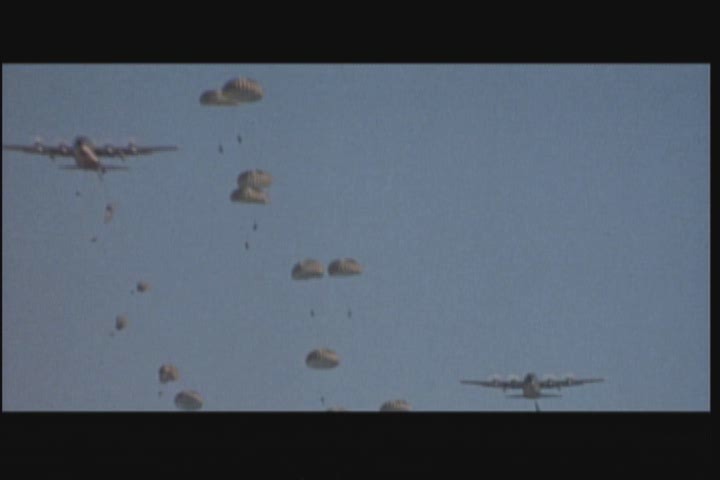
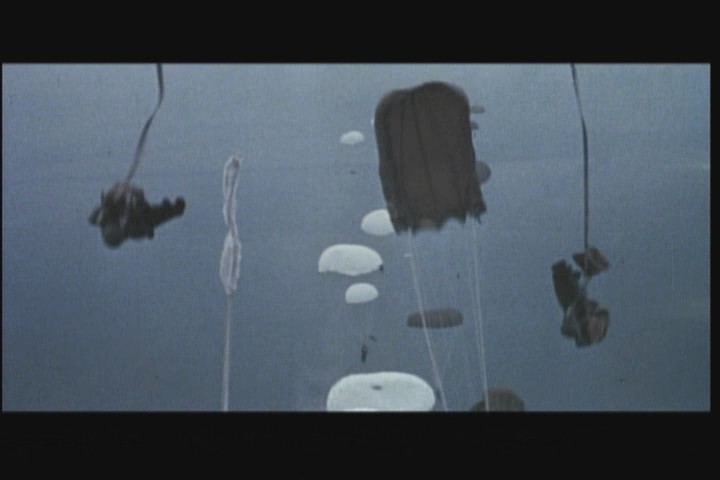
LVAD = Low Velocity Air Drop from 600-1200 feet
1
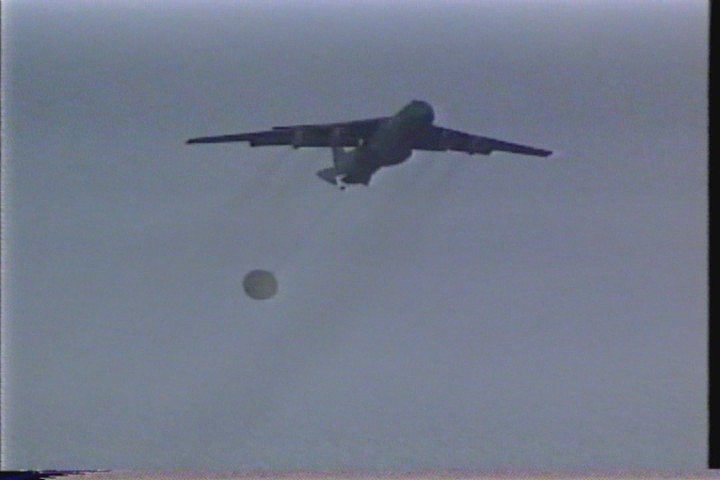
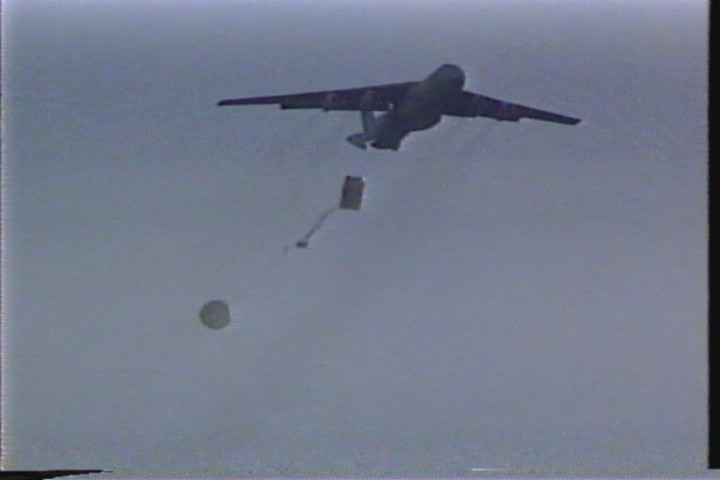
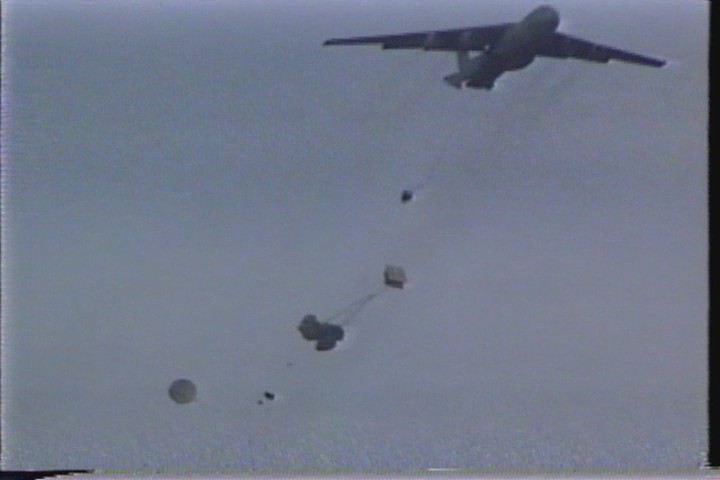
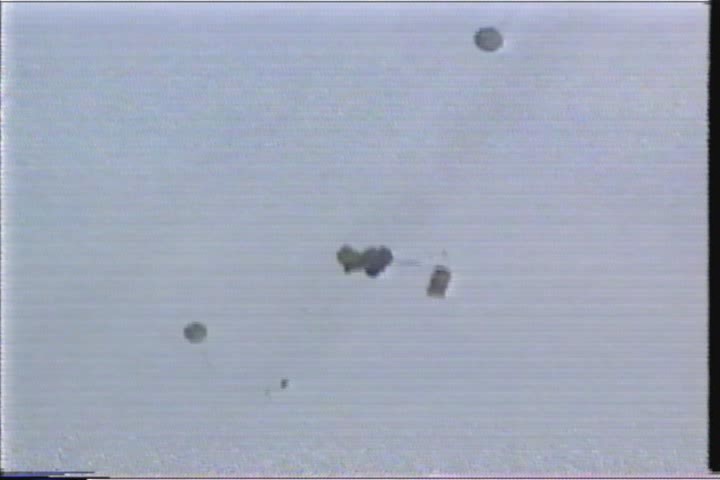 2
2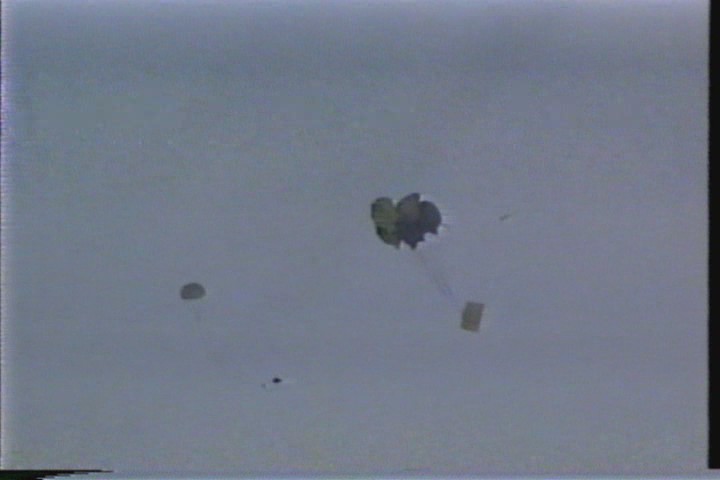
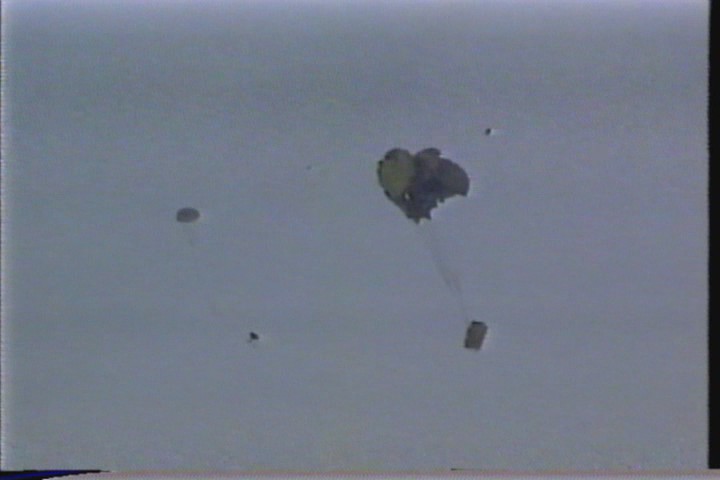
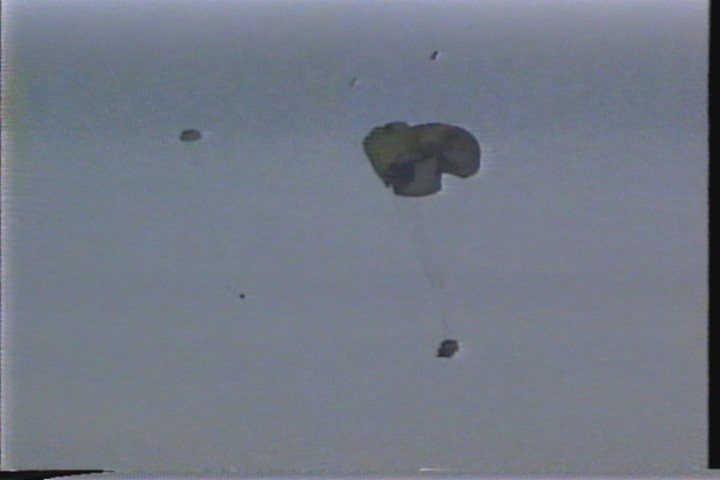
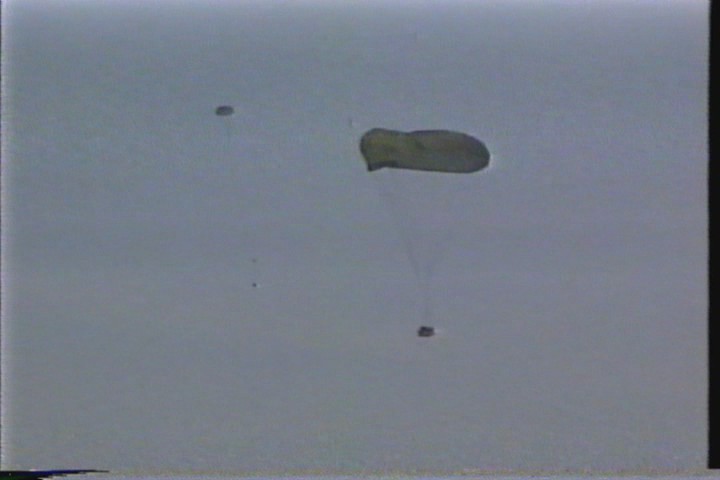
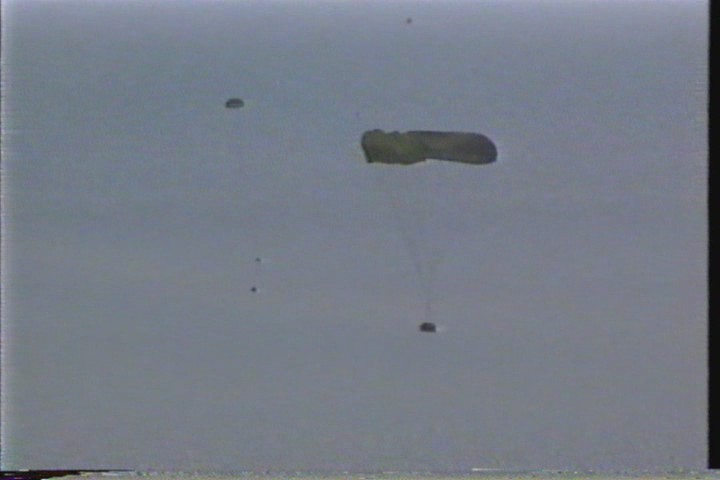 3
3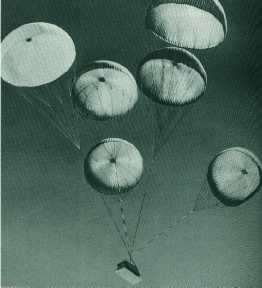
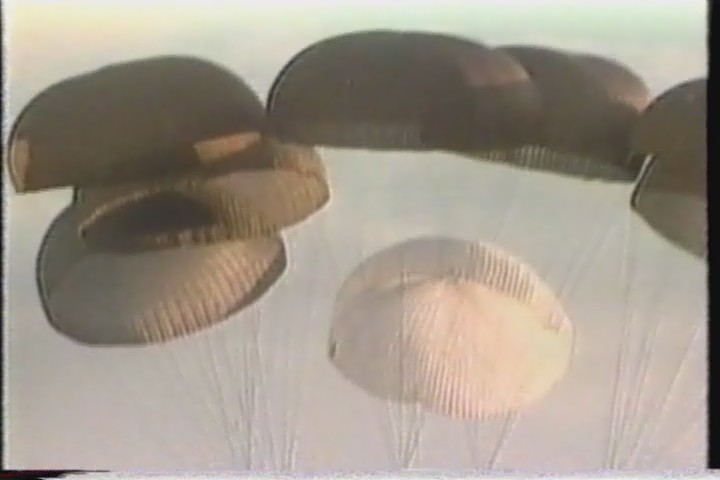
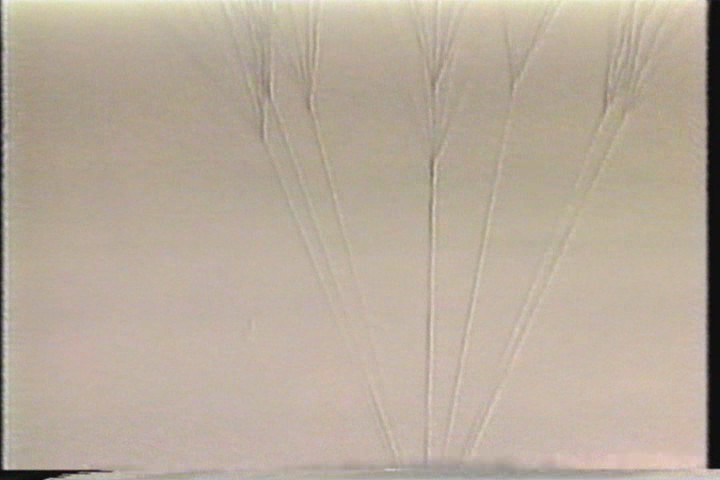
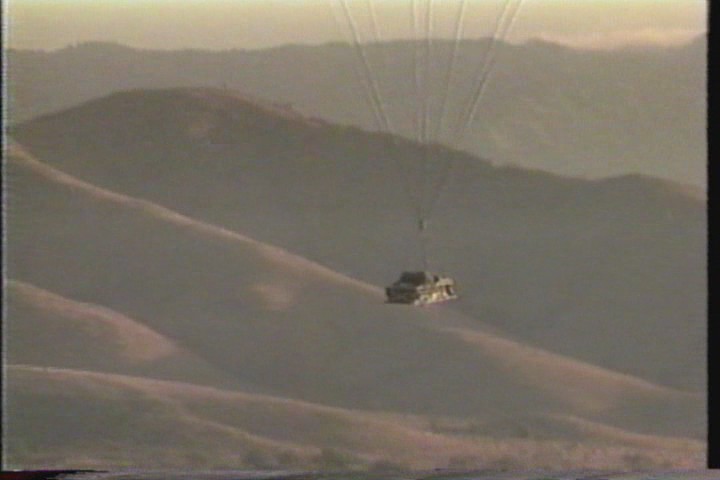
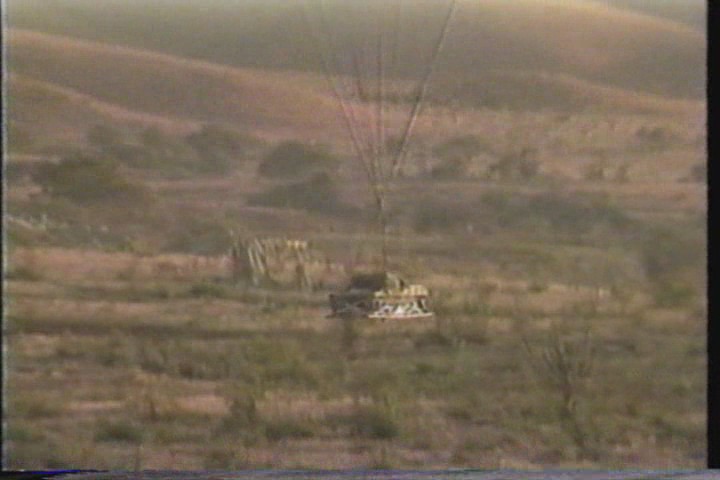
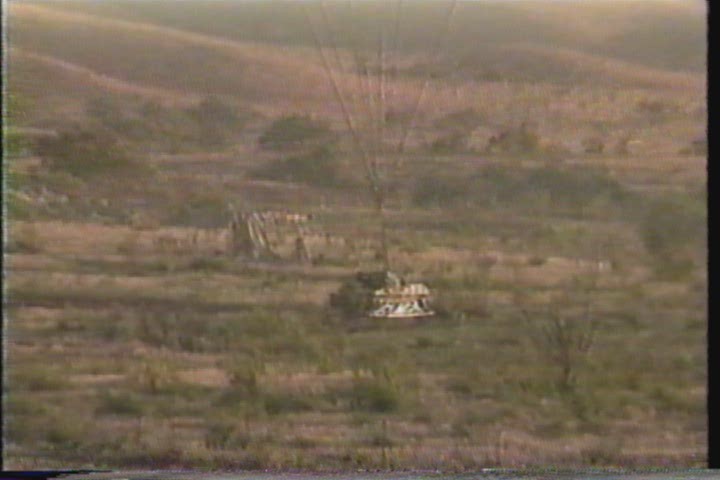
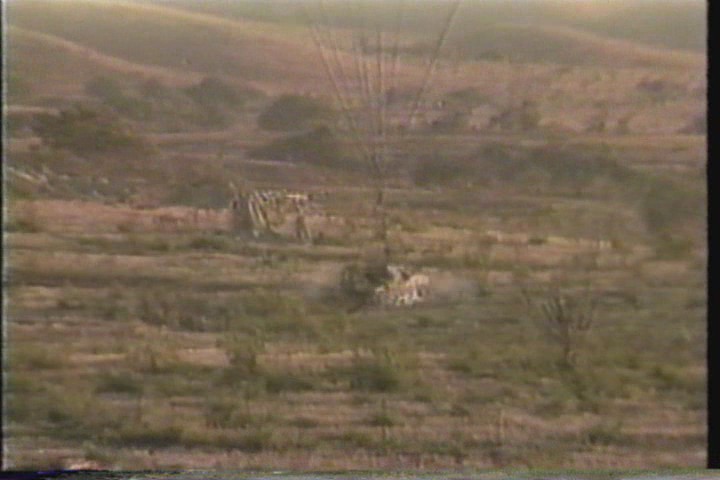 4
4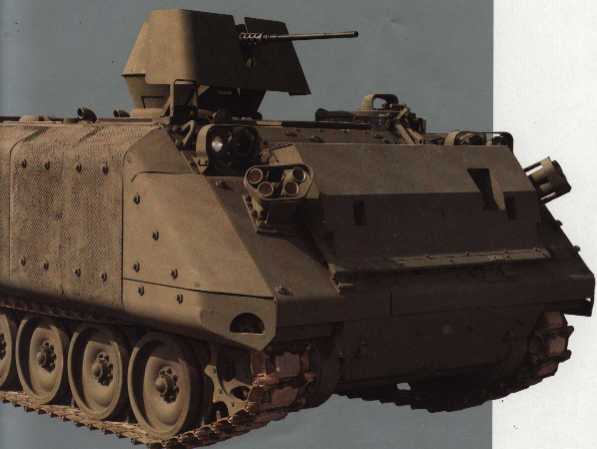
P-Hour...
"Twenty Minutes!"
The red light is on. The Jumpmaster shouts a time warning to the tactically cross-loaded Paratroopers sitting in rows inside the mighty C-130 Hercules 'chuted up for a night combat jump. Flying ahead of them in another serial of C-130s are their mounts: M113A4 Gavin light tracked armored fighting vehicles armed to the teeth with .50 caliber and 40mm heavy machine guns and TOW Improved Target Acquisition System (ITAS) anti-tank or assault "bunker busting" missiles. In the back of their vehicles several days worth of ammunition, food and water with space to carry a nine-man infantry squad around the battlefield. As the lead element of the 82nd Airborne Division, upon landing, Delta Company will fan out and secure road and key terrain blocking positions to isolate the drop zone from enemy counter-attacks to enable the main body of Alpha, Bravo and Charlie Companies to drop and secure their initial assault objectives and this is usually the airhead itself - a runway for non-airborne forces to land.
Ten minutes earlier, the Delta Company Commander, Captain John Hunter, had just received an en route mission update and was now briefing his jump Tactical Operations Center (TOC). "Men, we have a change of mission. The enemy is escaping across the border and we cannot sit around the airhead for follow-on forces to air land over the next few days. We are to leave behind a company to hold the airfield and proceed with the rest of the battalion to blocking positions along the border shown here on the digital map display graphics."
"Ten minutes!"
The EMPRESS console equips several aircraft for SECOMPS (secure enroute communications package). Normally it is the first four chalks (aircraft). Some commanders would like all chalks to have EMPRESS; an improved feature would be two small laptops wired near the paratroop doors. Small messages could be sent and acknowledged right up to about twelve minutes out. Since the message and update could be passed quickly towards the cockpit, situational awareness would dramatically rise, and it is in raising our knowledge of what is going on from P -:30 minutes to P -:10 minutes that is crucial. This is when the shaping of the battlefield occurs. Pre-assault fires will occur at this time to stun and suppress enemies below. Intelligence, Surveillance and Reconnaissance (ISR) platforms and Army Special Forces teams are already on the ground in large numbers to let them know what the situation is like.
"Outboard personnel, stand-up!"
As the Paratroopers struggle to their feet, the aircraft ahead known as the "heavy drop" birds are spitting out type V airdrop platforms with their mighty M113A4 Gavins strapped on top; a layer of protective honeycomb underneath with billowing extraction and huge cargo parachutes blossoming open to bring them to the ground with a thud.
The inboard personnel have now also stood up, and hooked up their static line snaphooks to their respective anchor line cables running along the top of the Herc's insides, and holding these yellow lifelines in their hands. These lines will pull open their canopies as they jump out the side paratroop doors of the aircraft.
The aircraft slows harshly, and then the Air Force loadmasters slide open both jump doors, sending a blast of cool, dry, night air through the stagnant atmosphere of the aircraft cargo compartment.
"Army, your door!"
The clear night is punctuated by red and green tracer fire from AC-130 Spectre gunships clearing out the remnants of the enemy battalion holding the airfield and enemy soldiers vainly returning fire. A-10 Warthogs drop fuel-air explosives, lighting the desert below in a fiery orange inferno, then pulling up and turning, virtually on a dime, to finish off any survivors with thirty millimeter cannon fire.
"One minute!"
The Jumpmasters make their final safety assessment, and quickly ascertain whether or not they are in the proper location.
"Stand By!"
The first jumper in each door takes up his door position, one foot on the jump platform, literally hanging outside the aircraft. Jumpmasters and jumpers alike stare intently at the red light affixed to both lead and trail edges of the gaping, black maw.
The green light goes on.
"Go!"
The entire planeload of Paratroopers begins jumping, one by one, two at a time out the twin jump doors, billowing canopies filling the night sky. From six hundred feet above ground level, a mere thirty seconds pass before each man will hit the ground and roll, remove his weapon from its case, shuck off his parachute harness, retrieve his rucksack, place it on his back and run towards the collection of M113A4 Super Gavins marked by infrared chemlights, visible only by night vision goggles (NVGs).
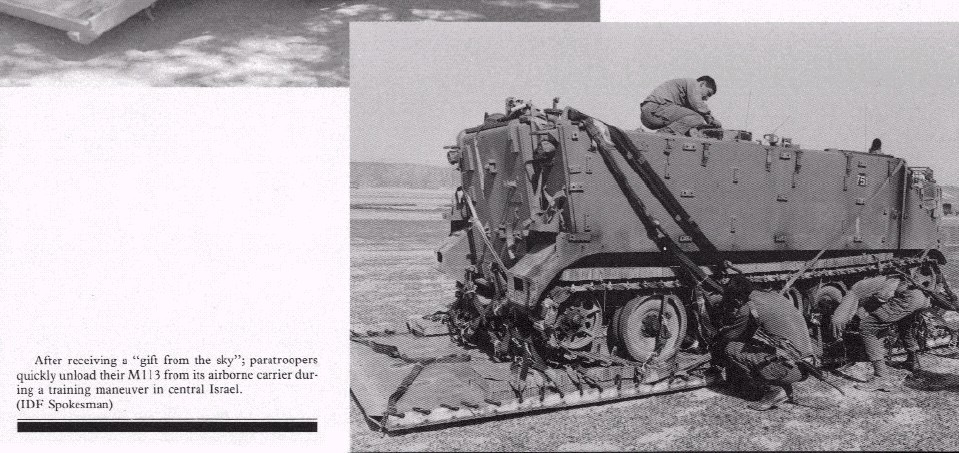
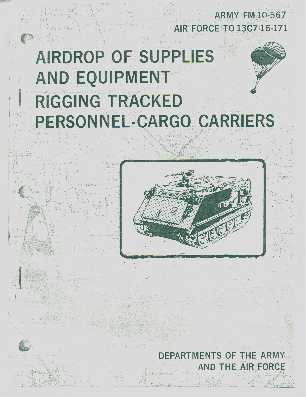
Soon the entire airborne battalion (minus one company) has motor-marched into blocking positions along the enemy border as the ITAS long-range thermal sights with a ten kilometer range spot the civilian Sport Utility Vehicles (SUVs). It is soon determined by cross-referencing intelligence documents on hand (for example, enemy leaders identification playing cards) that key enemy leaders are in these SUVs dressed in civilian garb. The order is given to engage with long-range TOW missile fires and take out the vehicles carrying the key leaders. As the TOW gunners place their cross hairs on their distant targets, the ITAS locks onto them for a surer aim to prevent missile drop-off after launch, and the missiles are launched into the night. Multiple gasoline explosions light the distant horizon as the TOW missiles find their marks, eliminating enemy leaders attempting to go into exile and make a future return to dictatorial power. The other escorting SUVs scatter and are engaged by .50 caliber (the beloved "Ma Deuce" in service since before World War Two) bullets and MK-19 forty-millimeter grenades shredding their tires and immobilizing them from further escape. Their hands held high in the air, the survivors walk towards the Americans who have by this time dispatched a full-sized infantry company ahead to thoroughly search the bodies and wreckage and capture the surrendering bodyguards.
The American Airborne is now on-the-ground as a Light Mechanized Rhodesian-Style, Quick-Reaction "Fire Force".
It Requires A Tracked Armored Vehicle
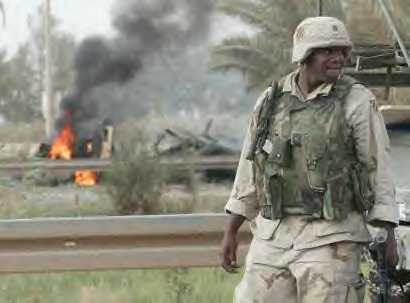
A HMMWV burns in the background after an ambush by RPGs and small arms fire in Iraq.
Falklands War decision: what would U.S. light infantry do?
Brigadier Julian Thompson in his book, No Picnic on page 11 writes:
"I was decided at an early stage in planning to take the minimum number of wheeled vehicles. The going anywhere in the Falklands away from the settlements was so bad that even a lightly loaded Landrover would be lucky to cover four miles an hour. Vehicles loaded with ammunition and stores would be lucky to move at all. The Brigade did have seventy-six of its BV202 oversnow vehicles in England, the remainder being stockpiled in Norway. Although designed to operate over snow there was a good chance that these vehicles with a ground pressure of only 1 1/2 lbs per square inch, about that of a man on skis, would be able to motor across the peat bog. Events were to prove they could."
How many tracked vehicles do U.S. Army light infantry units have to do a Falklands war, difficult terrain fight?
ZERO.
Here's a horror story from Iraq of American Light Infantry on Foot getting clobbered by Enemy High Explosive Land Mines
 www.youtube.com/v/ekUSOVAMah0
www.youtube.com/v/ekUSOVAMah0
Unfortunately, the Army's light units with Delta Anti-Tank (AT) Companies or platoons use unarmored, High-Mobility, Multi-purpose Wheeled Vehicles (HMMWV or "Humvees"); mere 4x4 trucks without the cross-country mobility, armor protection or space in the back to carry A, B, C Company infantry Soldiers as required to conduct real world missions such as rapidly fanning out from Drop Zones (DZs) or Landing Zones (LZs) into enemy territory to engage fleeting asymmetrical enemies as depicted in the scenario above.
Wheeled Trucks Are Not Effective Combat Vehicles
 www.youtube.com/view_play_list?p=3F7FFB8E9FF9505F
www.youtube.com/view_play_list?p=3F7FFB8E9FF9505F
The Humvee, as a wheeled sport utility not combat vehicle, simply cannot go cross-country at will through vegetation, soft soils, or up and down slopes. It is often road or trail bound, and thus easily ambushed and destroyed at Combat Training Centers (CTCs) like the Joint Readiness Training Center (JRTC) and sadly in combat in Afghanistan and Iraq. Wheeled vehicle are 28% less capable of armor protection than more weight/space efficient tracks. When you slap all kinds of armor on it, Humvee mobility degrades further and mechanically it starts breaking down. This is vividly described by Brigadier General Dan Bolger in The Battle for Hunger Hill and more ominously by real casualty reports in recent combat actions in Iraq, not to mention the 1993 Somalia raid described in the book and film; "Blackhawk Down!" The HMMWV is a truck, and not a combat vehicle, with air-filled rubber tires easily punctured and set on fire in a firefight resulting in a mobility kill, and potentially a total kill if the men inside do not get out of the vehicle. Delta Companies and AT platoons, as the main organic anti-tank and mobile security force for foot-mobile light infantry, must not be easily attrited or else the entire main body will be placed in a position of having to fight for its life. The Airborne must land and take the fight aggressively to the enemy without having a "glass jaw;" it must be able to fire and maneuver at will anywhere on the terrain and shrug off enemy fires encountered to attain important objectives - not be damaged and immobilized.
Non-Linear Battlefields Require FULL armor protection: tracks are 28% more capable of armor protection--and can go cross-country to avoid ambushes in the first place!
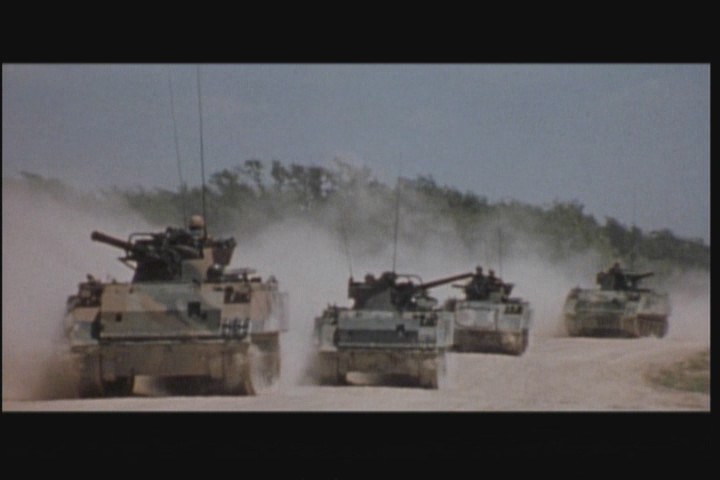
General James M. Gavin as Army Chief of Research & Development created the Airborne Armored Multi-Purpose Vehicle Family (AAM-PVF), the amazing M113 in the 1950s for maximum mobility over nuclear devastated, non-linear battlefields.
 www.youtube.com/v/zD4RWmotso0
www.youtube.com/v/zD4RWmotso0
The official history of the U.S. Army for that time period says the following:
www.army.mil/cmh-pg/books/amh/AMH-26.htm
The seven divisions stationed in the United States constituted the strategic reserve. Four of these-two airborne and two infantry-were designated in 1957 the Strategic Army Corps (STRAC) and were maintained in a high state of readiness for quick deployment in event of an emergency. The other three were earmarked as STRAC reinforcements and as a training base for expansion of Army forces should the crisis become prolonged or develop into a full-scale war.With the emphasis on mobility, even the larger and heavier weapons and equipment were designed to be air-transportable.
A program to produce ground and air vehicles with the necessary battlefield mobility led to the development of armored personnel carriers, such as the M113 with aluminum armor, that could move troops rapidly to the scene of operations while providing greater protection for the individual Soldier. Since
585
highways and bridges might be damaged or destroyed, dual-capability amphibious vehicles that could travel on rough terrain and swim across rivers and swamps freed the fighting units from total dependence upon roads.
What today's planners don't realize is that what was required for a nuclear battlefield is required today with PGMs in a Surveillance Strike System (SSC) that can be as equally devastating but in a more localized way: units ON TRACKS not wheels. We need GREATER PHYSICAL mobility, firepower, protection and livability features not less regardless if tied in to a "Mother May, I?" computer network to alleviate the anxieties of senior officials.
 www.youtube.com/v/MfzjqY0Pq3c
www.youtube.com/v/MfzjqY0Pq3c
 www.youtube.com/v/GrATZkFUhaI
www.youtube.com/v/GrATZkFUhaI
 www.youtube.com/watch?v=kW9RQsjTTno
www.youtube.com/watch?v=kW9RQsjTTno
 www.youtube.com/watch?v=6fxIAEW0djU
www.youtube.com/watch?v=6fxIAEW0djU
Thus, the M113's purpose was armored, amphibious, cross-country mobility for LIGHT, AIRBORNE units. In 1960, America's Airborne should have been the first ones to have "air-mech" capabilities organic but the ill-conceived ROAD reorganization plan reverted back to the paratroopers foot slogging and their armored tracks went to heavy units instead. Mass-produced and inexpensive, there was and still is enough M113s to supply BOTH light and heavy units. The old saying if you don't get it right, you spend the rest of your time trying to get it right comes to mind.
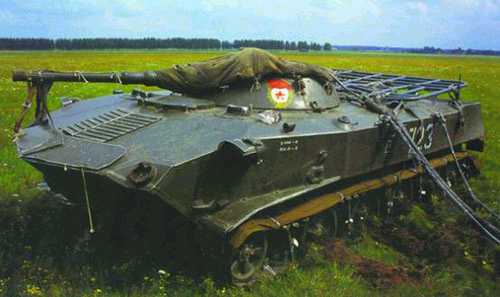
BMD-1 after parachute airdrop; note kneeling landing gear
Compare the U.S. Army in 2008 to the Russian Army of today...8 years after we revolutionized ground maneuver tactics with the M113 but sat on its potential, they created their own BMD and fielded one to every paratroop squad. They are already on their 4th Generation BMD and we are still trying to get "GEN I" M113 Gavins IN light units. What a disgrace to the memory of our great Airborne leaders, Gavin, Lee, Ridgway, Yarborough, Hackworth, Moore that we are not having American Light and especially Airborne forces---live up to their full potential.
U.S. Army TALKING about Light Units with M113 Gavin tracked armor (still after 4 decades of using them on & off)
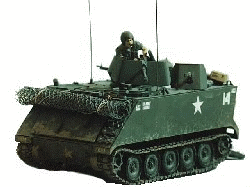
U.S. Airborne/Light units would be lucky just to have M113 Gavins with machine guns, much less autocannon...this wasn't always the case...the 82nd Airborne actually had M551 Sheridans and M113 Gavin light tanks in the 3rd Battalion, 73rd Armor until 1997.
www.stormingmedia.us/46/4652/A465262.html
Light Infantry, Augmentation, and the M113A3 Armored Personnel Carrier: A Step in the Direction of Versatility
Authors: William K. Sutey; ARMY COMMAND AND GENERAL STAFF COLL FORT LEAVENWORTH KS SCHOOL OF ADVANCED MILITARY STUDIES
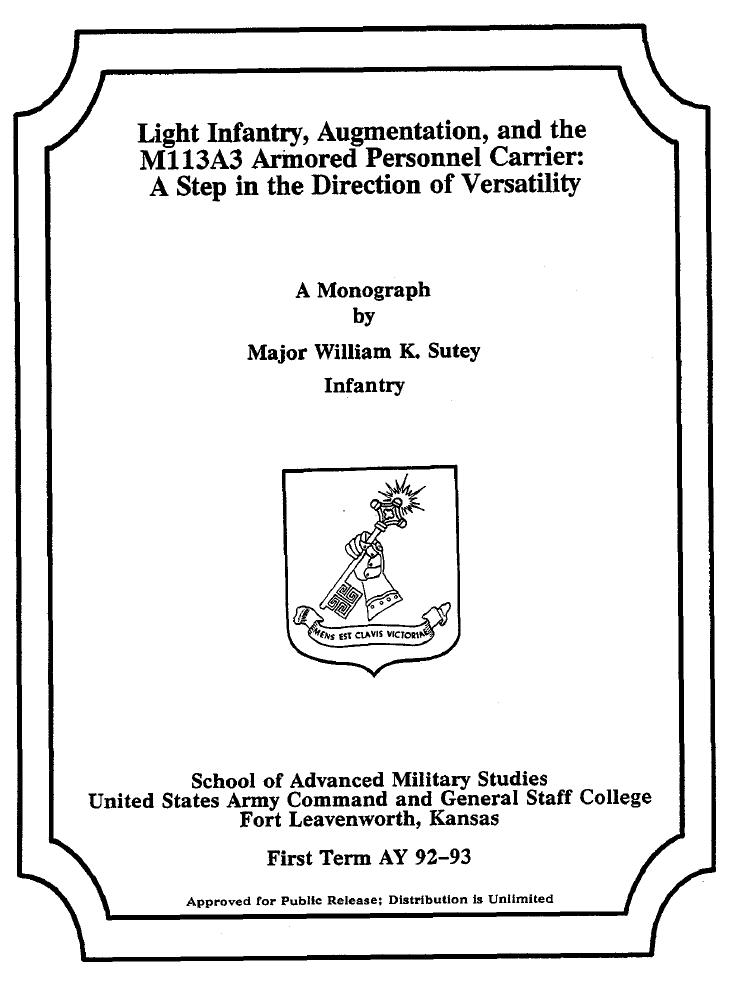
Abstract: This paper examines a proposal to create M113 Armored Personnel Carrier support units (vehicles, drivers, and service support) to provide protected tactical mobility augmentation for light infantry forces. Light infantry divisions are a crucial component of the Army's force structure to meet potential challenges across the spectrum of conflict. They lack, however, the tactical mobility assets to be of any utility beyond the lowest intensity conflicts in the most restrictive terrain. This limitation constrains the Army's versatility as a whole. This monograph first considers tactical mobility as an element of combat power, establishes an analytical framework for the analysis of the infantry mobility systems, and considers the heavily armed and mobile nature of potential world threats. Next, the light infantry concept is explored focusing on the intended purposes for which light infantry divisions were formed and an evaluation of their actual tactical mobility capabilities. Following this examination of today's light infantry, this paper looks at the Pentomic Era in the late 1950's in which M59 armored personnel carrier companies were consolidated at division level and sent vehicles as attachments to augment the tactical mobility of infantry units. Finally, this monograph conceptually outlines a proposal to use M113 APC's to augment deployed light forces and evaluates how this might enhance their utility. Although there are philosophical objections to, and practical problems with, augmenting light infantry with armored personnel carriers, this paper concludes that today's demands for maximizing the versatility of all forces merits reexamination of such a concept.
 www.youtube.com/watch?v=i3mn0ECMieY
www.youtube.com/watch?v=i3mn0ECMieY
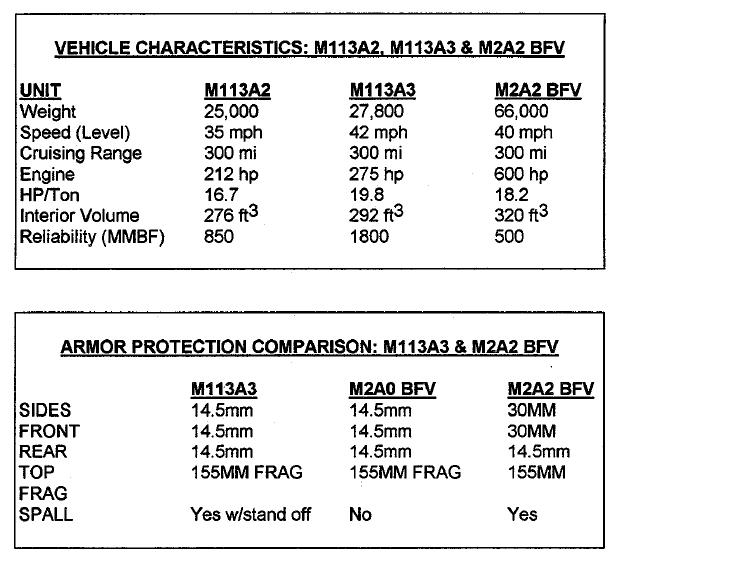
Sutey's armor package data is dated; Gavins start off better armored in their 1.5" to 1.75" thick hulls to 1" thick Bradley hulls. They also have fuel tanks outside to not incinerate everyone unlike the Bradley. Starting with this stronger and safer chassis "cake" today we can put the same and/or better armor "icings" on Gavins than Bradleys such that RPG, 30mm and ATGM protection levels are attained. A Gavin can also be v-hull shaped underneath to deflect mine blasts. As long as Bradleys have their fuel in the hulls, Gavins are far better protected even though they are 1/3rd the weight. Details:
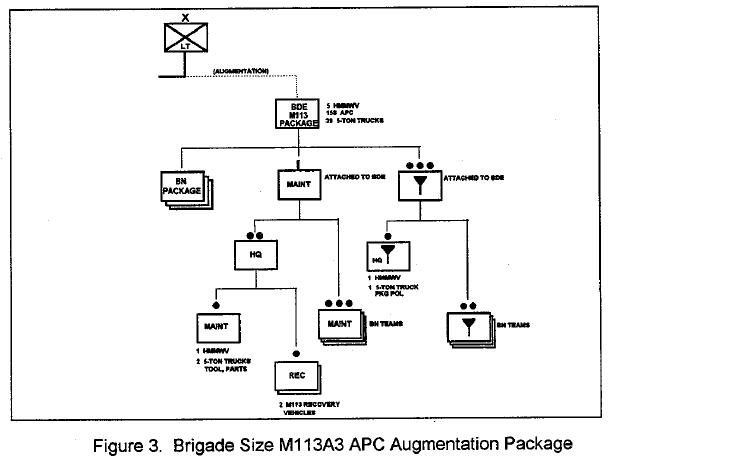
One way to light air-mechanize light infantry is by supplying a transportation package to the brigade combat team. We could have really used M113 Gavin packages to transport infantry faster than a foot-slog with better protection from enemy fire than riding on the back of tanks in the Korean War with the Regimental Combat Teams (RCT) concept.
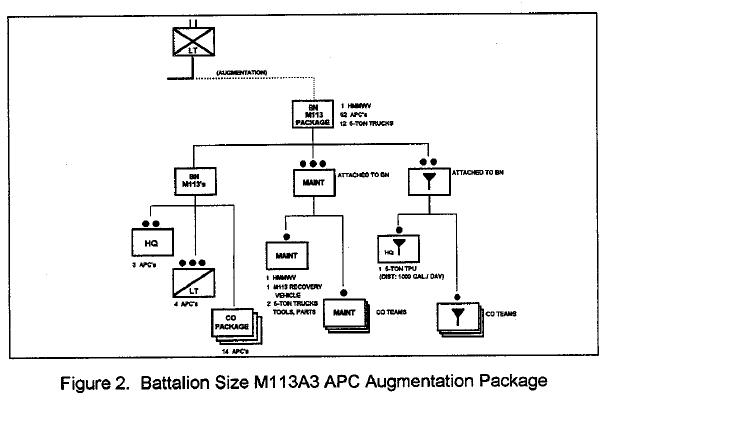
The company "Dragoon" package is what this web page advocates as the fastest and most efficient way to light air-mechanize our light infantry with least disruption to the MTOE.
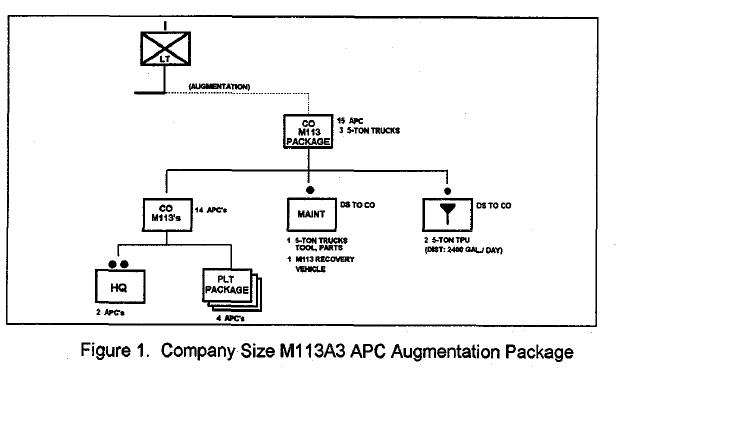
SHAME ON US: Russian VDV Airborne FIELDING BMD-4 tracked armor with 100mm guns
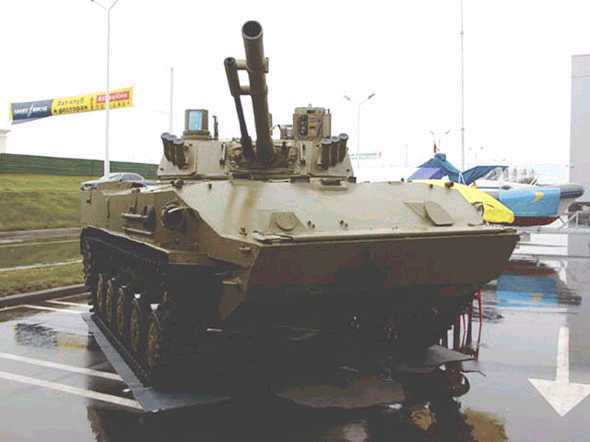
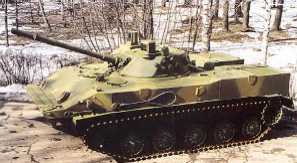
BMD-4 uses an improved versionm of the powerful 100mm main gun, 30mm autocannon, 7.62mm medium machine gun turret first fielded with the BMD-3M shown above
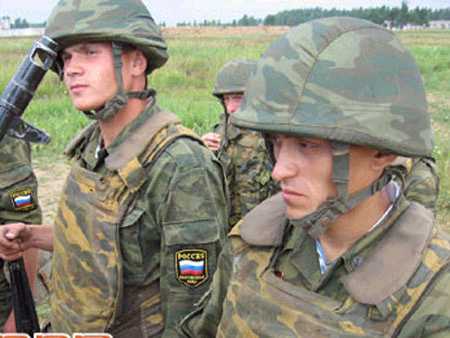
The Russian Paratroop crew of the BMD-4 ride INSIDE it during airdrop to save time de-rigging and getting it in action on the ground. Dismount paratroop infantry squad jumps out in FRONT of the IL-76 jet's engines SIMULTANEOUSLY with their mother BMD-4 exiting the rear ramp in order to land closer together. Their D-8 parachutes deploy only a stabilizer chute upon aircraft exit in order to jump in front of jet engine; U.S. old-fashioned static line and deployment bags leave a tangled mess streaming outside the plane as paratroopers exit.
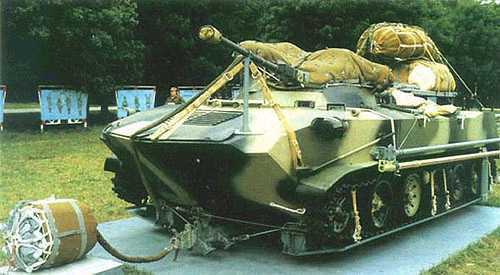
Note the minimalist approach to getting the BMD-4 to slide out the floor of cargo planes; runners under the tracks conserves weight and payload of the plane compared to the U.S. Type V airdrop platforms that each take up about 2, 000 pounds of payload and are a pain to recover on the drop zone for re-use.
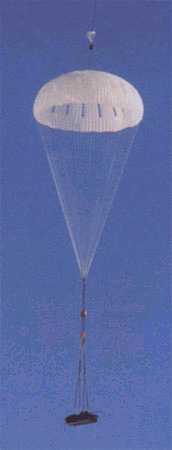
The BMD-4 under canopy
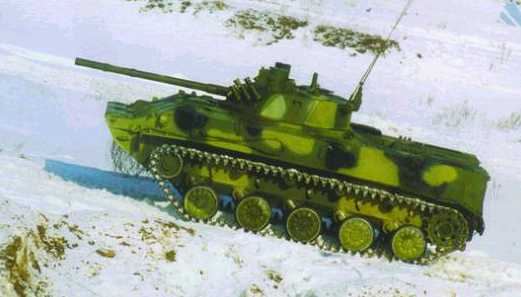
The BMD-4 has low ground pressure cross-country mobility like the M113 Gavin first pioneered
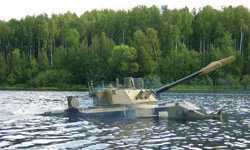
The BMD-4 has waterjets to swim in the ocean like the M113 "AmphiGavin" with the ARIS GATOR kit
 www.youtube.com/v/1hbUusptJbs
www.youtube.com/v/1hbUusptJbs
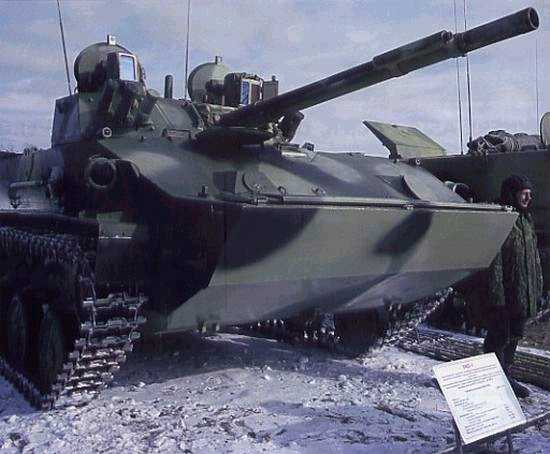
The BMD-4 has stabilized optics and gun mounts to shoot-on-the-move; a capability our M113 Gavins could have if they were OWNED BY LIGHT/AIRBORNE/AIR ASSAULT UNITS and improved on by ownership; ad hoc temporary load of M113s to units will not result in their full potential being achieved...and could result in the enemy killing a lot of Americans in battle because we chose to be inferior.
http://en.rian.ru/russia/20060616/49637256.html
New combat vehicles on way to Russian airborne units
19:24 | 16/ 06/ 2006
MOSCOW, June 16 (RIA Novosti) - Russia's Airborne Forces will receive the first batch of a new armored airborne combat vehicle on June 21, an army spokesman said Friday.
The BMD-4 airborne combat vehicle is amphibious, light and well armed. Like its predecessor, BMD-3, it has a hull made of special alloys and a turret, but features many modifications. In addition, it is equipped with a 100-mm gun.
"The start of deliveries of the BMD-4 marks a new era in the development of the Airborne Forces and will significantly raise the combat strength of Russia's most mobile units," Alexander Cherednik said.
The vehicle will be shown off during an exercise on June 26 that senior officers are expected to attend.
Legendary Tanker Ralph Zumbro asks the question:
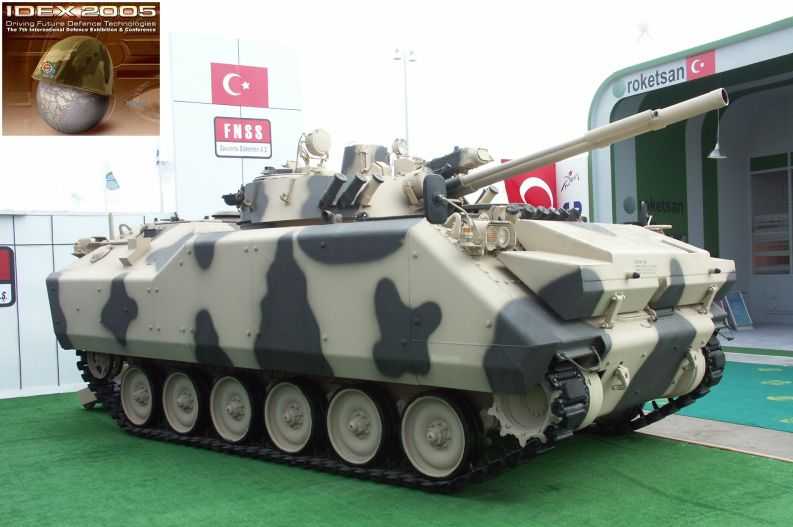
Nurol of Turkey has a M113-based AIFV with a BMD-3 type turret
"Gents;
That turret sounds like a development of the BMP-3 turret which at lease one ex Russian/Soviet country has adapted to the M-113. Maybe we ought to just BUY them and adapt them to our vehicle????"
Ralph
SIDEBAR: Meet a Delta Heavy Weapons Company in the 82nd Airborne:
 www.youtube.com/watch?v=9BxrSVW6IRA
www.youtube.com/watch?v=9BxrSVW6IRA
The goal of our Delta Weapons company video was to showcase the "icing" positives of having vehicle-mobile heavy machine guns and anti-tank/assault missiles that are parachute forced-entry capable in the hands of skilled U.S. Army Paratroopers. You'll see what its like to jump out of a C-130 from a "bird's eye view" via our "ruckcam" we attached to the outside of a rucksack.
Meet the "RuckCam"
RuckCam pouch
Another View
Rear View showing ON/OFF record button access
Inside view
However, clearly, their air-filled rubber-tire wheeled Humvee truck "cake" platforms are inadequate in terms of mobility and protection even in unarmored configuration they are restricted to roads/trails though they can "float" over cross-country terrain if the ground is firm and not too uneven or vegetated. You will also see in the video that at Fort Bragg, training areas are restricted and not conducive to cross-country maneuver in wheeled trucks. Their Humvees do not even have gunshields for exposed gunners on top. So-called "up-armored" M1114 Humvee trucks are too heavy to do any kind of cross-country travel, overheat and break when trying to sustain 50 mph road speeds. Their windshields, 4 door patchwork of slapped on armor offers too many entry points for enemy blast effects to penetrate and kill everyone inside. Its obvious that the Army's light units that have their heavy machine guns, anti-tank/assault and mortars weapons transported by Humvee trucks need to be re-equipped with M113 Gavin light tracked armored fighting vehicles with solid one-piece armored hulls that can go cross-country at will via tracked mobility; to include breaking brush ahead along uneven and soft ground; swim across lakes and rivers to avoid roadside bomb ambushes, while providing superior all-around armored protection when attacking the enemy.
A light tracked armored vehicle will survive on the DZ longer than an unarmored HMMWV rubber-tired truck; up-armored HMMWVs have been found too fragile to even survive the parachute drop and are not TOW ITAS-capable. Since the U.S. Army Airborne drops heavy platforms prior to troops, it is possible that any surviving enemy may enjoy a few minutes with our heavy drop items alone on the DZ. In a single battalion airborne assault, one can expect at least twenty-two vehicles and artillery platforms to be heavy dropped. It is estimated that for at least five minutes, there is a window of opportunity in which the enemy could spray every heavy drop platform he can see with small arms fire, as it sits alone on the DZ. For an unarmored HMMWV or howitzer, both with air-filled rubber tires, this is bad news. In contrast, if the item tolerates 7.62-millimeter hits like armored vehicles, this is perversely beneficial because it allows the enemy to waste bullets that will harmlessly bounce off the armored skin of an M113, and not the Paratroopers that are thirty seconds away in the personnel chalks.
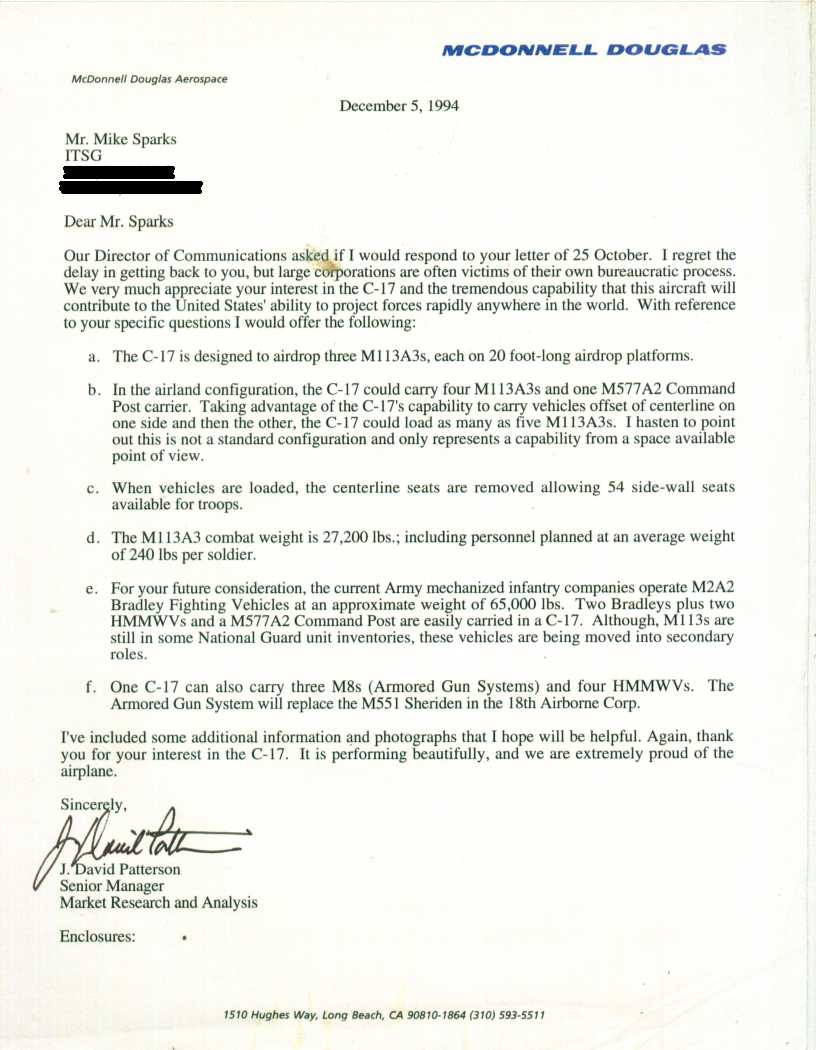
Considerations for the 173rd Airborne Brigade's HMMWV's vulnerability to a possible pair of Iraqi armored divisions made force planners choose to "seize and hold" an airfield in northern Iraq rather than to fan out to cut-off border escape routes to capture fleeing Iraqi leaders.
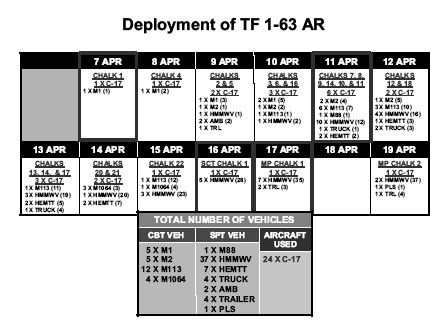
By the time heavy M1A2 Abrams heavy, M2 Bradley medium and M113A3 Gavin light tanks were airlanded, the enemy had already crossed the border into Syria. In airborne three-dimensional (3D) maneuver operations, the window of opportunity for exploiting the situation is measured in minutes and hours; if we are to exploit our perceived advantage in mental situational awareness, we must have the physically agile means to move out instantly from the forced-entry to attain mission objectives. We must parachute airdrop not airland our vehicles.
BREAKING NEWS!!!
Inside The Army
February 16, 2004
Pg. 1
Paratroopers' Needs Rekindles Talk Of Defunct Armored Gun System
The 82nd Airborne Division at Ft. Bragg, NC, still needs a rapidly deployable vehicle with firepower, a requirement some say could be met sooner rather than later if the Army is willing to shake the mothballs from its defunct Armored Gun System, sources say.
"They want an air-droppable platform for forced entry," said a service source, and "they want it now."
As a result, the division recently passed along an "operational needs statement" to Army Forces Command that outlines the unfulfilled requirement, said Maj. Rich Patterson, a spokesman for the 18th Airborne Corps, which oversees the division. The Army's operations and plans office, or "G-3," is reviewing the requirement with Training and Doctrine Command, but no decision has been reached, Patterson said.
While Army leadership may determine AGS is not the solution, the idea of moving the system back into the limelight, at least in a limited way, has caught the attention of a lawmaker who represents the Ft. Bragg area.
The requirement for an air-droppable platform has existed at least since the late 1990s, when the division disbanded one of its battalions -- the 3rd Battalion of the 73rd Armored Regiment, which was equipped with an aging armored reconnaissance vehicle called the Sheridan. At the time, service officials thought other capabilities would become available to the Paratroopers once the M551 Sheridan retired.
When the division deactivated the armored battalion in 1997, however, Army officials had already terminated AGS, which had been regarded as the Sheridan's replacement. Proposed in the 1980s as a lightweight combat vehicle that could fit aboard a C-130, AGS featured a 105mm cannon, an ammunition autoloader and options for armor protection. United Defense LP had produced a handful of prototypes of the vehicle in 1996, when then-Army Chief of Staff Gen. Dennis Reimer terminated the program. Eliminating AGS freed more than $1 billion over the service's outyear funding plan -- money that was badly needed for other cash-strapped programs, officials said at the time.
What was not eliminated was the need to equip light forces with an air-droppable platform that had enough firepower to hold off opposing forces until heavier forces arrived, sources said.
According to the Army's program executive office for ground combat systems, five AGS prototypes exist today. Four systems reside at UDLP's manufacturing facility in York, PA; one is at a UDLP facility in San Jose, CA.
Herb Muktarian, a spokesman for UDLP's ground systems division in York, said the four M8 AGS vehicles there have been regularly maintained.
"They are in a standard configuration and are in excellent condition," he said. "We are prepared to provide the vehicles and any required support if we were to receive an official request from the Army."
The unmet requirement has caught the attention of Rep. Robin Hayes (R-NC), a member of the House Armed Services Committee whose district includes Ft. Bragg. Hayes contacted the Army's legislative liaison office last December requesting specifics on the ongoing "discussion about getting the AGS" into Army "tactics, techniques and procedures."
"What is your assessment of the immediate operational need for a system to support airfield seizure, forced entry and other missions of the 82nd Airborne Division?" Hayes asked in a Dec. 15, 2003, e-mail. "Can the AGS serve as a near-term solution to an immediate operational need?"
Hayes requested several other details from the Army, including the cost of reviving AGS, spare parts needs and the status of the 82nd Airborne's needs statement. Hayes' spokesman, Jonathan Felts, said Feb. 10 that the congressman has not yet received a response from the Army.
"Congressman Hayes' top priority is that we help our Soldiers in the field as quickly as possible," Felts wrote in a statement.
"Let me be very clear to say that this is not a matter of advocating one system over another," he added. "Rather, the congressman knows that there is an existing technology presently sitting unused, and he is simply inquiring if it is feasible to utilize the capabilities while awaiting future technologies that are in production."
The division's interest in an AGS-like system is nothing new. The division's 17th Cavalry Regiment expressed a desire for such a system several years ago, according to the Army source.
As Inside the Army reported in the fall of 1999, service officials then were looking at all vehicles that could serve as a near-term solution for light forces -- including AGS, the marine corps' Light Armored Vehicle, the Pandur lightweight vehicles used by the Kuwait National Guard and a variant of the M113 armored personnel carrier (ITA, Oct. 4, 1999, p1; Sept. 27, 1999, p1).
The PEO for ground combat systems, which had overseen the AGS program, was directed to conduct a review of the various candidates. For AGS, the office provided Army leaders information on three options: field AGS in the state it was in when the program was terminated; revamp the system with newly developed technologies, then field it; or field AGS in the condition it was in when terminated, but with plans to retrofit the system with new technologies.
Past inquiries into AGS and other systems, however, have failed to "go anywhere," the service source said.
Pulling AGS out of storage might be a more tenable idea today, however, than in 1999 when then-Army Chief of Staff Gen. Eric Shinseki announced plans to invest heavily in a lighter, more lethal future force. After years accepting considerable risk in its current force to fund transformation goals, the Army once again shifted gears last year to focus on ensuring the current force -- stretched thin across the globe -- is adequately equipped. Gen. Peter Schoomaker, who took over Shinseki's job last August, told reporters in October 2003 that he had directed his staff to scrub the force and its transformation plans for existing technologies and equipment that could be used by troops in Iraq or Afghanistan (ITA, Oct. 13, 2003, p1).
-- Anne Plummer
FYI the Army has already a field manual online outlining how to employ a light armor platoon using M8 Buford Armored Gun System light tanks, called FM 17-18 Light Armor Operations:
Army Digital Library
www.adtdl.army.mil/cgi-bin/atdl.dll/fm/17-18/f1718.htm
However the Airborne will need infantry to accompany and escort the M8 AGS light tanks and these can moved in conjunction by employing 11-ton M113A3 Gavin light tracked armored personnel carriers which were flown into Northern Iraq by 3D maneuver and were very effective during the 2D maneuver drive into Baghdad:
www.geocities.com/equipmentshop/m113combat.htm
The Army has thousands of M113 Gavins in storage and they are certified for parachute airdrop. The easiest way to employ M8 AGS light tanks and M113 Gavins would be by designating an infantry battalion's "Delta" Weapons company to use M8s/M113s instead of vulnerable HMMWV trucks. Details:
www.combatreform.org/itmaneuversabattalion.htm
Lastly, the reason the Airborne desperately needs light tracked armored vehicles is best shown in the power point show I made for the Airborne Combat Engineers:
www.geocities.com/lightmechsappers
Another ominous development is the use of airborne foot-mobile troops thrown in the back of HMMWV and other type cargo trucks to mop up pockets of enemy resistance, following in the paths cleared by Army mechanized units such as the 3rd Infantry Division, which are fully ground fire and maneuver capable, in tracked armored fighting vehicles. Students of military history will recall that in World War Two German Wehrmacht Field Marshal Erwin Rommel had no choice in the vast, expansive open desert but to use his Italian foot-mobile light infantry to mop up and hold supply lines and bases. As we learned the hard way in Mogadishu, and more recently in Iraq with the marines, motorized infantry in unarmored trucks are not prudent to make first and sustained combat with an enemy who has armored fighting vehicles, Rocket Propelled Grenades (RPGs), machine guns, artillery, and mortars. Units that lack tracked armored mobility will not play the leading (or perhaps any) role in desert warfare, and in other terrain types will fight at a distinct disadvantage if the enemy has better mobility, protection, and firepower.
It Takes Infantry
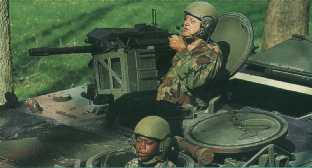
Just three Soldiers man most Delta Company HMMWVs: a driver, a vehicle commander and a gunner for either a Tube-launched, Optically-tracked, Wire command link guided Anti-Tank Guided Missile (TOW ATGM), .50 caliber heavy-barreled machine gun or a 40mm Mk-19 heavy machine gun. This leaves at best just one infantryman who can dismount from the vehicle to conduct such tasks as providing local security, observing down avenues of approach that are blind spots for the driver or gunner, removing wire and other obstacles, and detecting mines. As the reader can quickly assess, this one man is not enough to do this task and it is worth considering that without more dismounted infantry the Delta Companies can barely provide their own security when stopped. In Afghanistan, it became necessary to carry more infantry task organized for route clearing, village sweeps of suspected terrorists, and cordon and searches over suspected terrain. These extra infantrymen were forced to sit cramped, four at a time, in the HMMWV missile hatchback area. An unsafe and less than ideal practice since they lacked seats, belt restraints, clear fields-of-fire and shielding from enemy fires.
In an airfield seizure package (a two battalion mission), there are four to five AT platoons of HMMWVs in a heavy drop. Certainly the AT gun trucks can bring firepower and move out, but they can't move rifle squads to protect themselves from being ambushed. So potentially there is a possible replay of Freddie Gough's jeep squadron's demise at Arnhem ("A Bridge Too Far") during World War Two.
 www.youtube.com/v/VSm5nBZ4X0A
www.youtube.com/v/VSm5nBZ4X0A
It Takes Full-Cross-Country, Amphibious Armored Mobility
 www.youtube.com/v/9VMgdFUd1JU
www.youtube.com/v/9VMgdFUd1JU
Clearly, for a Delta Company to hunt and kill enemy tanks it must have mobility superior to its prey; road and trail-bound HMMWVs, even unarmored, are simply at a mobility disadvantage against tracked vehicles. Against a combined-arms enemy who skillfully employs suppressive artillery and mortar fires ahead of its main body of tanks, the unarmored Delta Company HMMWVs could be damaged and destroyed by area fires and unable to employ their long-range Improved TOW Acquisition Sight's (ITAS) observation and missile-firing capabilities. Delta Companies must be as close to one-hundred percent terrain mobile in any terrain anywhere in the world in order to get into observation and firing position first to exploit American advantages in sensors and night vision; this includes lake and river swimming to get into unassailable firing positions since most medium and heavy tanks cannot swim.
The answer to all of the above requirements is to make several 82nd Airborne Delta Companies fully mission dominant by replacing their thirty-five, four-ton HMMWV wheeled trucks with thirty-five, eleven-ton light tracked armored vehicles, initially M113A2 Gavins from Army war stocks. The M113 Gavin is a combat proven air-droppable, amphibious, cross-country mobile armored box that can employ the Delta Company's current weaponry as well as have space inside for permanent scouts or a task-organized nine man infantry squad from A, B or C Companies. A whole array of appliqué armors to protect against auto-cannon and Rocket Propelled Grenades (RPGs); Command, Control, Communications, Computers, and Information (C4I) situational awareness gear; infrared camouflage ghillie coverings; rubber "band tracks;" gun shields; turrets and mounts are available that can be added on at unit level as experience is gained using the Gavins.
 www.youtube.com/v/RbWbkOkTydk
www.youtube.com/v/RbWbkOkTydk
 www.youtube.com/v/9SPHgpLWPws
www.youtube.com/v/9SPHgpLWPws
Depot-level improvements of larger engines, stretched hulls, hybrid-electric drive trains, and larger engines make the -A3 and later versions the most mobile and stealthy armored vehicles in the world. Currently fifty percent of an Army heavy Division rides in M113 Gavins; trained mechanics, Prescribed Load List (PLL), and logistics are already in place to supply and maintain these simple vehicles. The day is coming when the enemy will "own a piece of the night" and we will need stealthy fighting vehicles that are fully camouflaged against enemy electro-optics to include thermals.
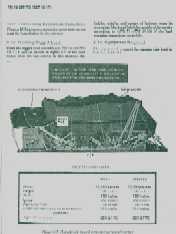
The HMMWV is now parachute airdropped on a 16-foot type V platform. The M113 is airdropped on a 20-foot airdrop platform. Although the Gavin is seven tons heavier, the fact that its volume is only a few feet longer than a HMMWV means a Delta Company's thirty-five vehicles can be parachute air-delivered using the same number of heavy drop aircraft. For example, inside a C-130 you can only airdrop one sixteen foot to twenty foot platform with either a HMMWV or a M113 on top; there is not enough width for troops to sit alongside, so space for a second platform must be used instead for troop seats. This is a reason why the 82nd likes to fill aircraft with either all personnel or all equipment and drop them onto separate DZs, even though this means slower assembly and more time exposed on the ground.
The 82nd, 101st, 173rd and 1-501st Airbornes have "Delta" heavy weapons (TOW anti-armor and heavy machine guns) COMPANIES that are easily re-equipped with M113 Gavins instead of 35 x Humvee trucks to give A, B and C companies armored mobility on the battlefield. A stretch hull MTVL can carry 10-15 men so 35 x M113A4 Gavins could carry 350-525 men per sortie. Airborne/Air Assault units have support platoons with 6 x 2.5 ton cargo capacity FMTV and 2 Humvee trucks. If you replaced these 8 unarmored, unarmed vehicles with 8 Gavins, we gain an ARMORED resupply capability that is cross-country mobile that can fight its way to reach the infantry to resupply them. This also increases the number of men that can be transported in one lift to 430-645. This takes care of 22 battalions in the U.S. Army today, giving them situational light mechanized capabilities.
What about the 10th, 25th and 172nd Light Infantry Battalions?
What About Modularity Reorganized Light Brigade Combat Teams?
The same concept as described above but with lesser numbers.
www.globalsecurity.org/military/agency/army/bct-heavy.htm
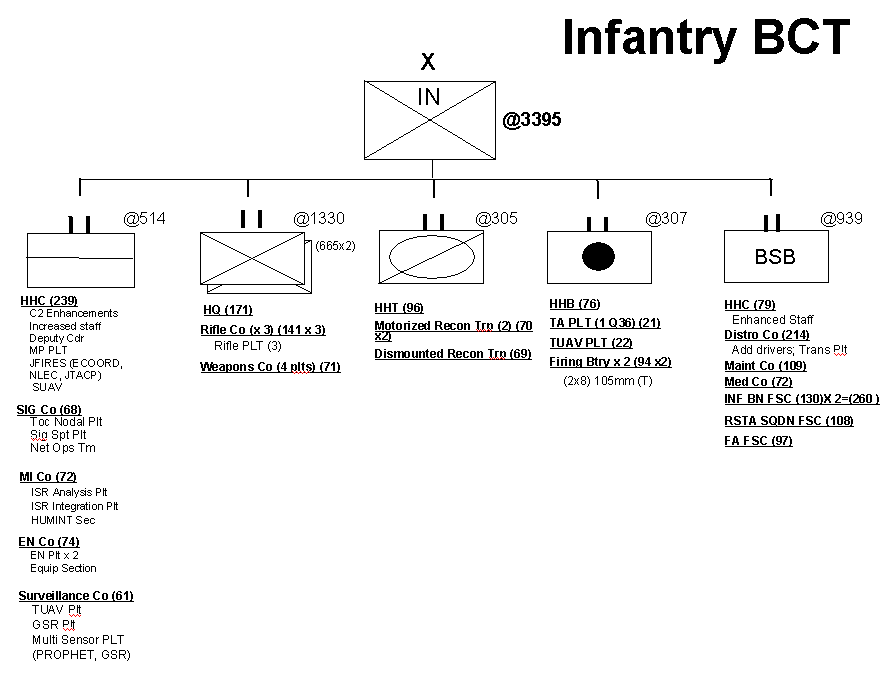
There is one very good thing in former Army Chief of Staff General Schoomaker's modularity reorganization. Now every infantry battalion has a Delta weapons company with it appears 23 x Humvee road-bound trucks that can easily be swapped out for 23 x M113 Gavin light armored tracked APCs/Tanks to carry TOW ATGMs, .50 caliber and MK-19 40mm heavy machine guns that can also transport A & B, or B & C or A & C company infantry with cross-country, amphibious, armored mobility as needed. In HHC, the 81mm mortars can be upgraded to 120mm and/or mounted inside M1064A3 Gavin light tracked carriers to give immediate fire support out to 5 or 7+ km ranges to include guided GPS bombs to reach out to those Taliban rebels running for the hills.
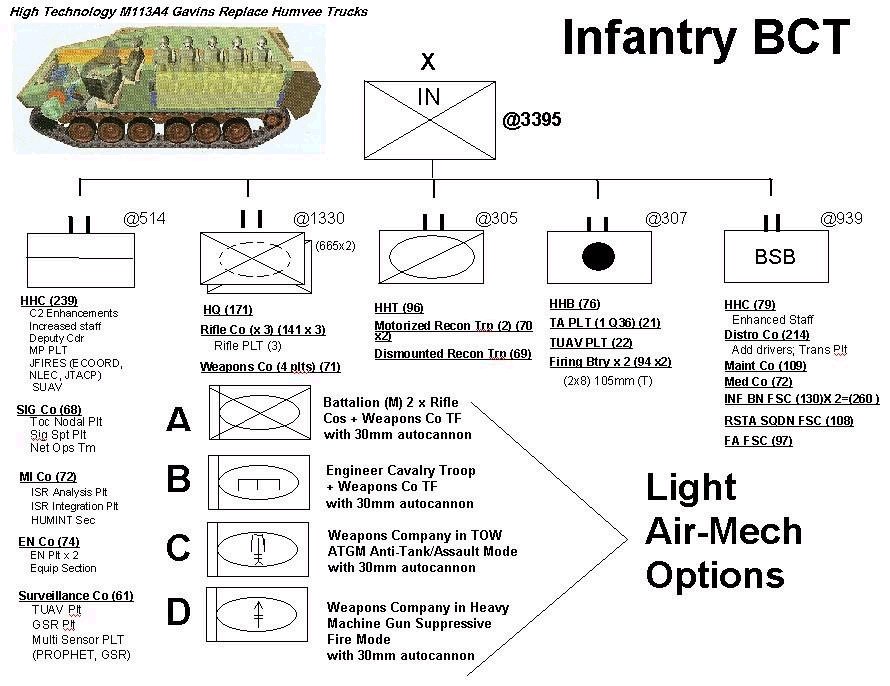
The motorized recon squadron in the modularity LBCT would be drastically improved if their flimsy, immobile Humvee trucks were replaced by M113 Gavin scout vehicles. During Operation Desert Storm in Iraq, M113 Gavins had to lead the way because Humvee trucks are too vulnerable and Bradleys not mobile enough--the U.S. Army already has its "Future Scout Vehicle" (FSV)--upgrading its M113s with high technology will make them even better! Everything Captain Tien wants for the FSV (shoot-on-move, stabilized weapons, thermal vision etc.) can be applied TODAY to existing M113 Gavins!
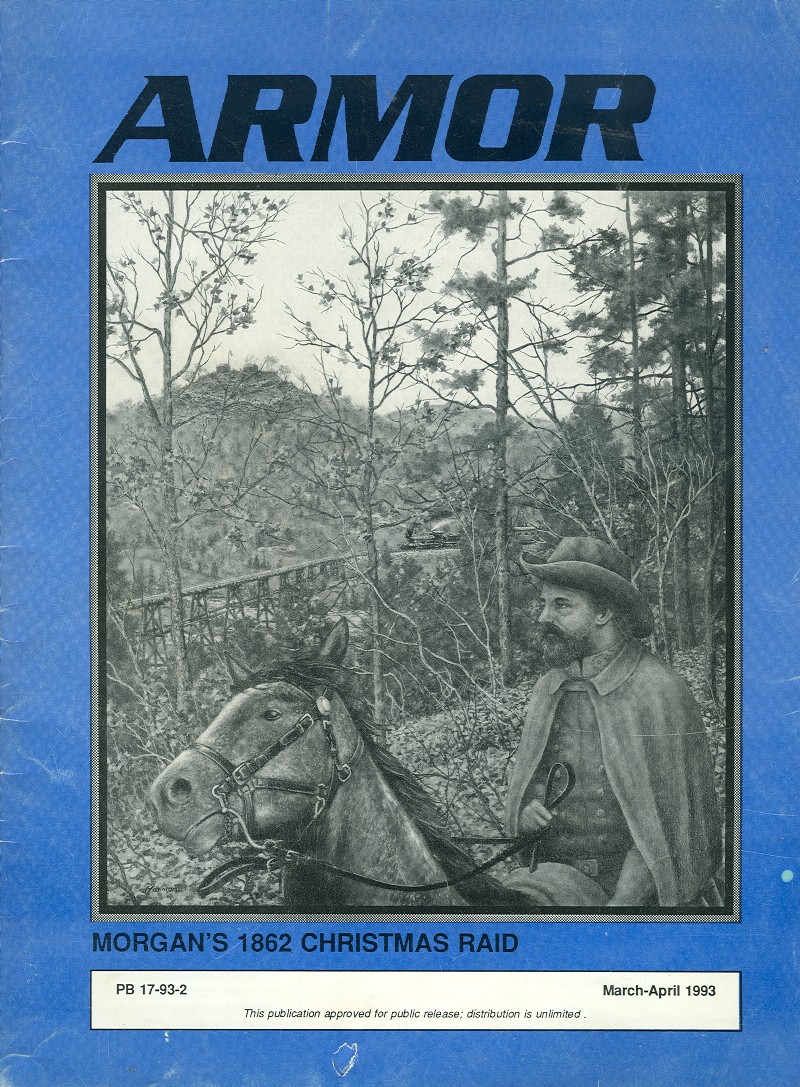
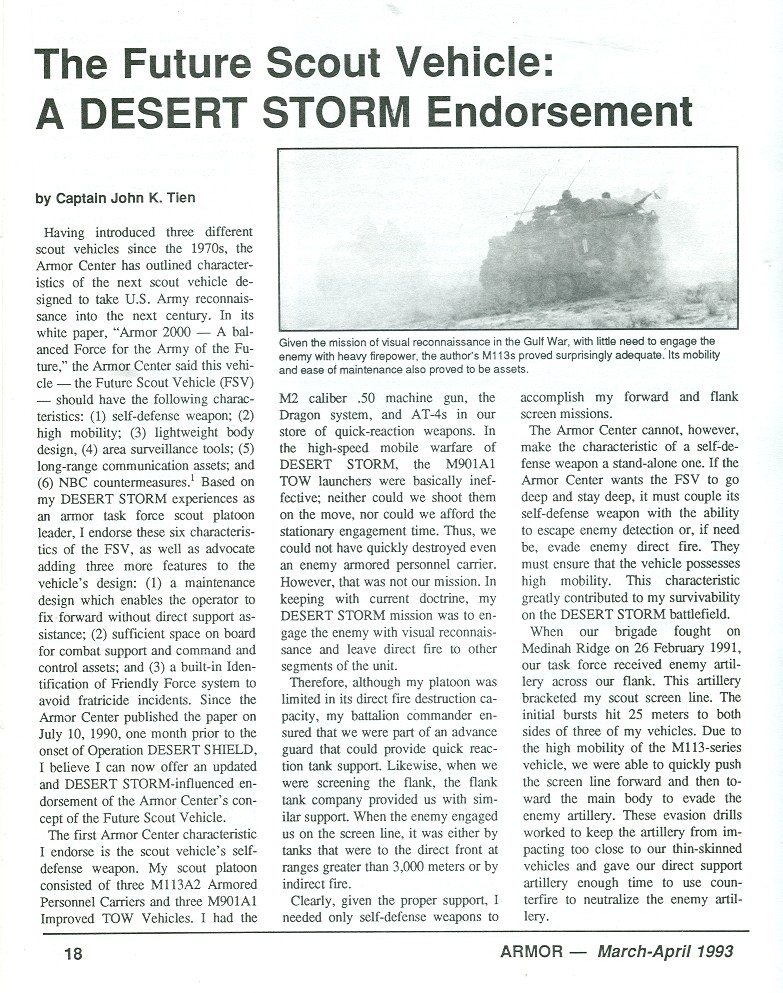
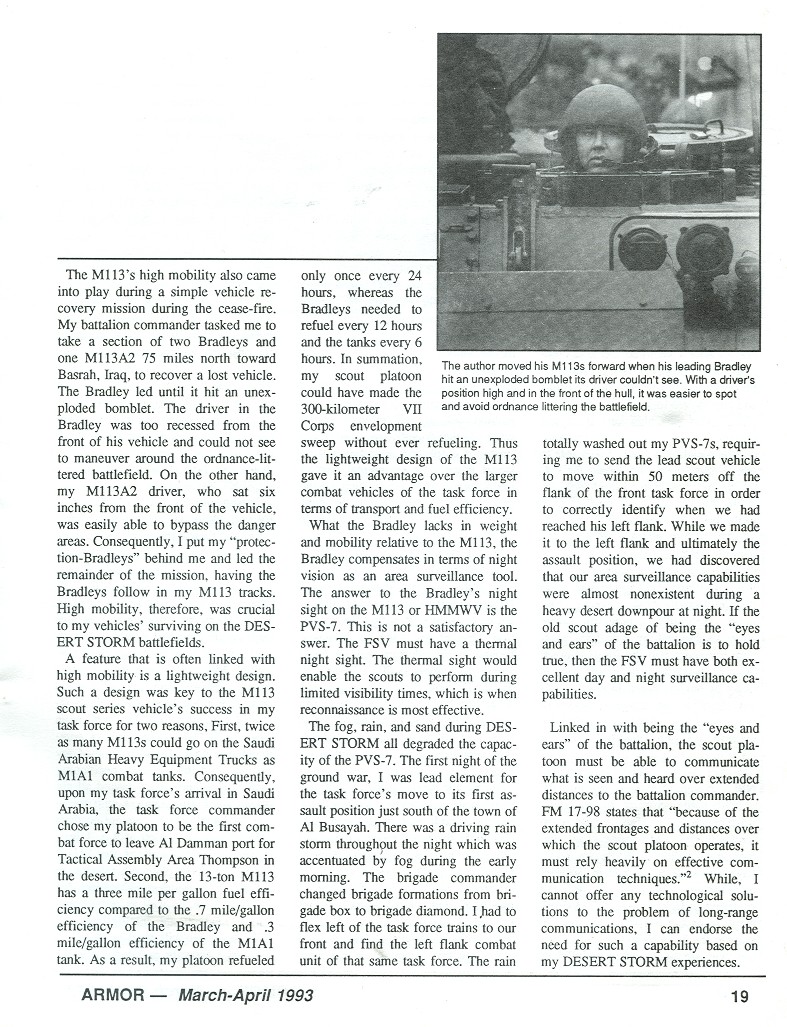
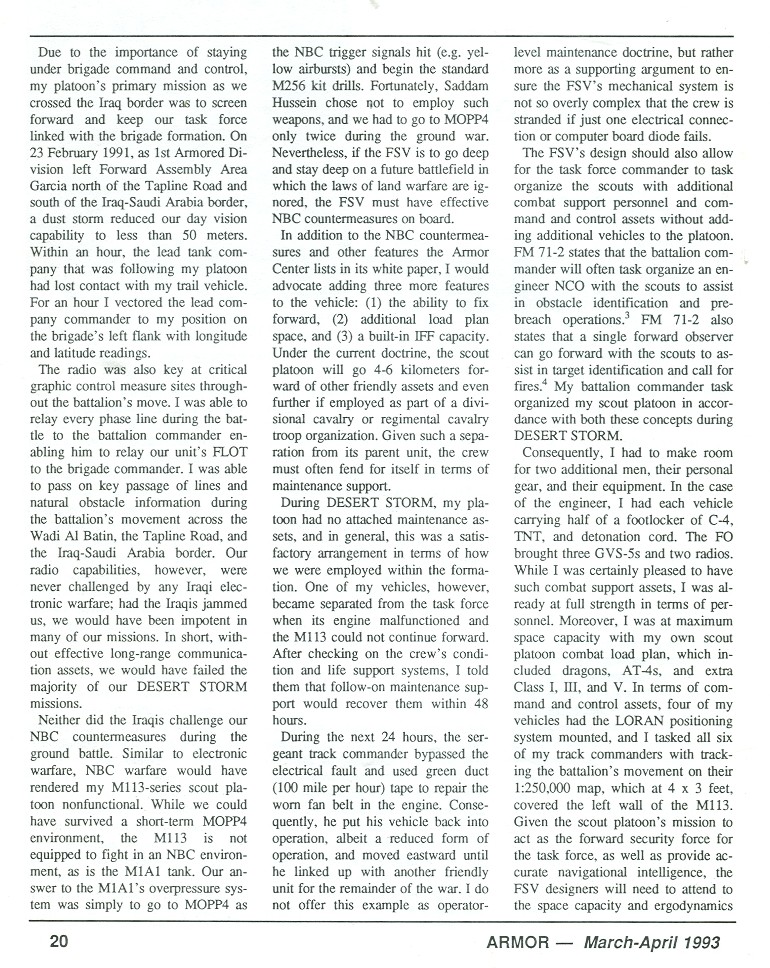
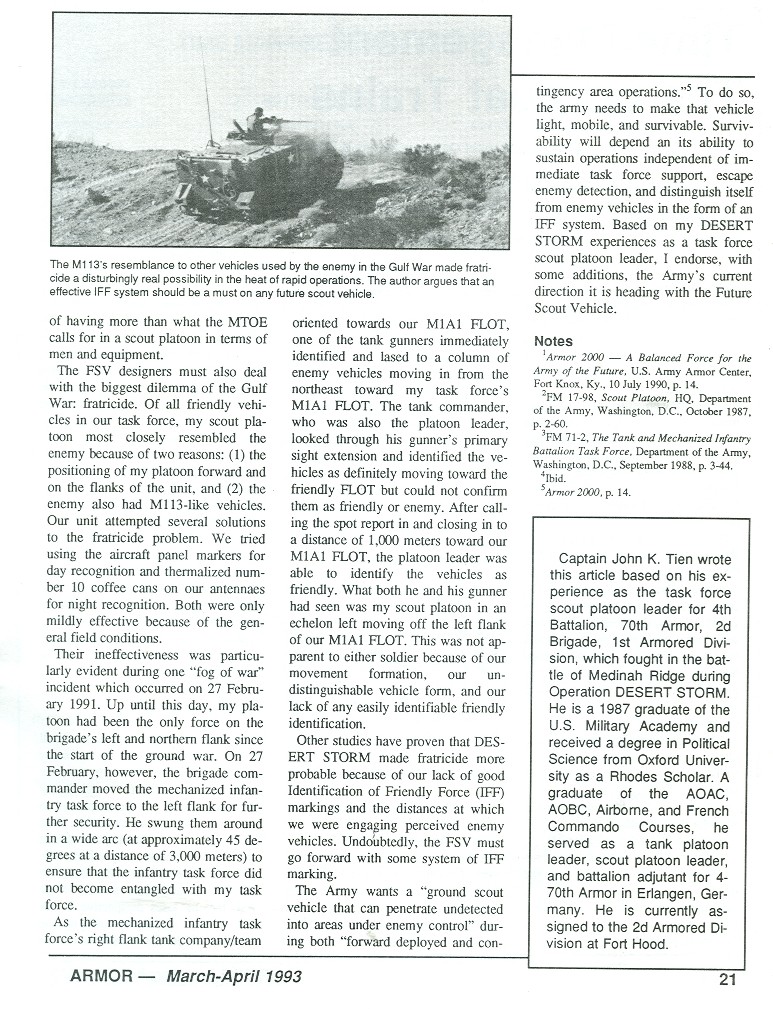
U.S. Army ARMOR Magazine - March-April 1993The Future Scout Vehicle: A DESERT STORM Endorsement
by Captain John K. Tien
Having introduced three different scout vehicles since the 1970s, the Armor Center has outlined characteristics of the next scout vehicle designed to take U.S. Army reconnaissance into the next century. In its white paper, "Armor 2000 - A balanced Force for the Army of the Future," the Armor Center said this vehicle - the Future Scout Vehicle (FSV) - should have the following characteristics: (1) self-defense weapon; (2) high mobility; (3) lightweight body design, (4) area surveillance tools; (5) long-range communication assets; and (6) NBC countermeasures.[1] Based on my DESERT STORM experiences as an armor task force scout platoon leader, I endorse these six characteristics of the FSV, as well as advocate adding three more features to the vehicle's design: (1) a maintenance design which enables the operator to fix. forward without direct support assistance; (2) sufficient space on board for combat support and command and control assets; and (3) a built-in Identification of Friendly Force system to avoid fratricide incidents. Since the Armor Center published the paper on July 10, 1990, one month prior to the onset of Operation DESERT SHIELD, I believe I can now offer an updated and DESERT STORM-influenced endorsement of the Armor Center's concept of the Future Scout Vehicle.
The first Armor Center characteristic I endorse is the scout vehicle's self defense weapon. My scout platoon consisted of three M113A2 Armored Personnel Carriers and three M901Al Improved TOW Vehicles. I had the
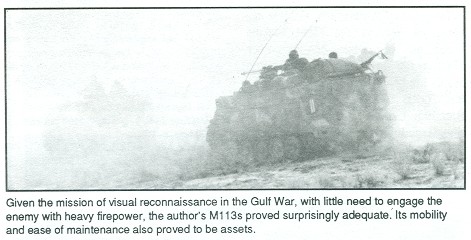
Given the mission of visual reconnaissance in the Gulf War, with little need to engage the enemy with heavy firepower, the author's M113s proved surprisingly adequate: Its mobility and ease of maintenance also proved to be assets.
M2 caliber .50 [heavy] machine gun, the Dragon [anti-tank guided missile] system, and AT-4s in our store of quick-reaction weapons. In the high-speed mobile warfare of DESERT STORM, the M901A1 TOW launchers were basically ineffective; neither could we shoot them on the move, nor could we afford the stationary engagement time. Thus, we could not have quickly destroyed even an enemy armored personnel carrier.
However, that was not our mission. In keeping with current doctrine, my DESERT STORM mission was to engage the enemy with visual reconnaissance and leave direct fire to other segments of the unit.
Therefore, although my platoon was limited in its direct-fire destruction capacity, my battalion commander ensured that we were part of an advance guard that could provide quick reaction tank support. Likewise, when we were screening the flank, the flank tank company provided us with similar support. When the enemy engaged us on the screen line, it was either by tanks that were to the direct front at ranges greater than 3,000 meters or by indirect fire. Clearly, given the proper support, I needed only self-defense weapons to accomplish my forward and flank screen missions.
The Armor Center cannot, however, make the characteristic of a self-defense weapon a stand-alone one. If the Armor Center wants the FSV to go deep and stay deep, it must couple its self-defense weapon with the ability to escape enemy detection or, if need be, evade enemy direct fire. They must ensure that the vehicle possesses high mobility. This [M113 Gavin] characteristic greatly contributed to my survivability on the DESERT STORM battlefield.
When our brigade fought on Medinah Ridge on 26 February 1991, our task force received enemy artillery across our flank. This artillery bracketed my scout screen line. The initial bursts hit 25 meters to both sides of three of my vehicles. Due to the high mobility of the M113-series vehicle, we were able to quickly push the screen line forward and then toward the main body to evade the enemy artillery. These evasion drills worked to keep the artillery from impacting too close to our thin-skinned vehicles and gave our direct support artillery enough time to use counterfire to neutralize the enemy artillery.
Page 18
The M113's high mobility also came into play during a simple vehicle recovery mission during the cease-fire.
My battalion commander tasked me to take a section of two Bradleys and one M113A2 75 miles north toward Basrah, Iraq, to recover a lost vehicle.
The Bradley led until it hit an unexploded bomblet. The driver in the Bradley was too recessed from the front of his vehicle and could not see to maneuver around the ordnance-littered battlefield. On the other hand, my M113A2 driver, who sat six inches from the front of the vehicle, was easily able to bypass the danger areas. Consequently, I put my "protection-Bradleys" behind me and led the remainder of the mission, having the Bradleys follow in my M113 tracks. High mobility, therefore, was crucial to my vehicles' surviving on the DESERT STORM battlefields.
A feature that is often linked with high mobility is a lightweight design. Such a design was key to the M113 scout series vehicle's success in my task force for two reasons, First, twice as many M113s could go on the Saudi Arabian Heavy Equipment Trucks as M1A1 combat tanks. Consequently, upon my task force's arrival in Saudi Arabia, the task force commander chose my platoon to be the first combat force to leave Al Damman port for Tactical Assembly Area Thompson in the desert. Second, the 13-ton M113 has a three mile per gallon fuel efficiency compared to the 0.7 mile/gallon efficiency of the Bradley and 0.3 mile/gallon efficiency of the M1A1 tank. As a result, my platoon refueled only once every 24 hours, whereas the Bradleys needed to refuel every 12 hours and the tanks every 6 hours. In summation, my scout platoon could have made the 300-kilometer VII Corps envelopment sweep without ever refueling. Thus, the lightweight design of the M113 gave it an advantage over the larger combat vehicles of the task force in terms of transport and fuel efficiency.
What the Bradley lacks in weight and mobility relative to the M113, the Bradley compensates in terms of night vision as an area surveillance tool. The answer to the Bradley's night sight on the M113 or HMMWV is the PVS-7. This is not a satisfactory answer. The FSV must have a thermal night sight. The thermal sight would enable the scouts to perform during limited visibility times, which is when reconnaissance is most effective.
The fog, rain, and sand during DESERT STORM all degraded the capacity of the PVS-7. The first night of the ground war, I was lead element for the task force's move to its first assault position just south of the town of Al Busayah. There was a driving rain storm throughout the night which was accentuated by fog during the early morning. The brigade commander changed brigade formations from brigade box to brigade diamond. I had to flex left of the task force trains to our front and find the left flank combat unit of that same task force. The rain
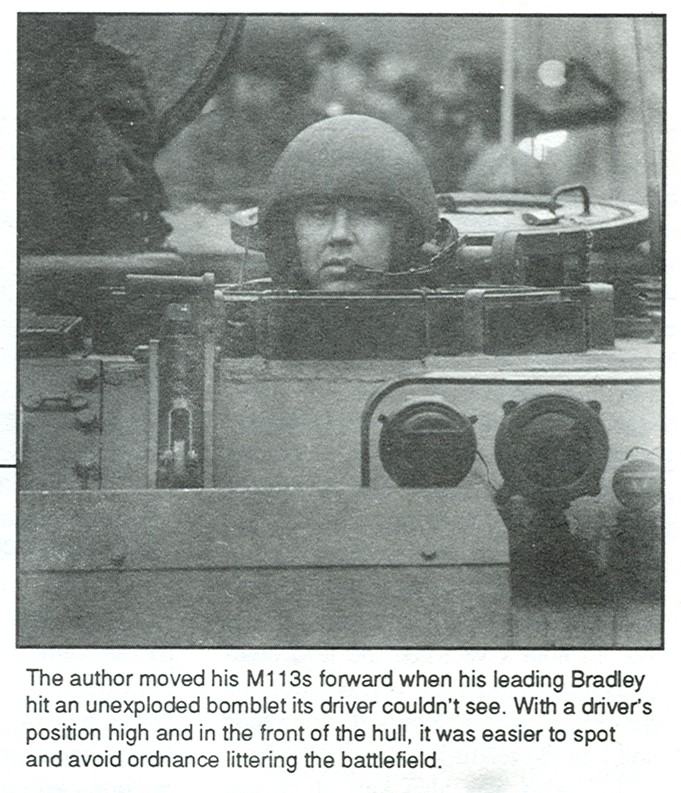
The author moved his M113s forward when his leading Bradley hit an unexploded bomblet its driver couldn't see. With a driver's position high and in the front of the hull, it was easier to spot and avoid ordnance littering the battlefield.
totally washed out my PVS-7s, requiring me to send the lead scout vehicle to move within 50 meters off the flank of the front task force in order to correctly identify when we had reached his left flank. While we made it to the left flank and ultimately the assault position, we had discovered that our area surveillance capabilities were almost nonexistent during a heavy desert downpour at night. If the old scout adage of being the "eyes and ears" of the battalion is to hold true, then the FSV must have both excellent day and night surveillance capabilities.
Linked in with being the "eyes and ears" of the battalion, the scout platoon must be able to communicate what is seen and heard over extended distances to the battalion commander. FM 17-98 states that "because of the extended frontages and distances over which the scout platoon operates, it must rely heavily on effective communication techniques." [2] While, I cannot offer any technological solutions to the problem of long-range communications, I can endorse the need for such a capability based on my DESERT STORM experiences.
Page 19
Due to the importance of staying under brigade command and control, my platoon's primary mission as we crossed the Iraq border was to screen forward and keep our task force linked with the brigade formation. On 23 February 1991, as 1st Armored Division left Forward Assembly Area Garcia north of the Tapline Road and south of the Iraq-Saudi Arabia border, a dust storm reduced our day vision capability to less than 50 meters. Within an hour, the lead tank company that was following my platoon had lost contact with my trail vehicle. For an hour I vectored the lead company commander to my position on the brigade's left flank with longitude and latitude readings.
The radio was also key at critical graphic control measure sites throughout the battalion's move. I was able to relay every phase line during the battle to the battalion commander enabling him to relay our unit's FLOT to the brigade commander. I was able to pass on key passage of lines and natural obstacle information during the battalion's movement across the Wadi Al Batin, the Tapline Road, and the Iraq-Saudi Arabia border. Our radio capabilities, however, were never challenged by any Iraqi electronic warfare; had the Iraqis jammed us, we would have been impotent in many of our missions. In short, without effective long-range communication assets, we would have failed the majority of our DESERT STORM missions.
Neither did the Iraqis challenge our NBC countermeasures during the ground battle. Similar to electronic warfare, NBC warfare would have rendered my M113-series scout platoon nonfunctional. While we could have survived a short-term MOPP4 environment, the M113 is not equipped to fight in an NBC environment, as is the M1A1 tank. Our answer to the M1A1's overpressure system was simply to go to MOPP4 as
Page 20
the NBC trigger signals hit (e.g. yellow airbursts) and begin the standard M256 kit drills. Fortunately, Saddam Hussein chose note to employ such weapons, and we had to go to MOPP4 only twice during the ground war.
Nevertheless, if the FSV is to go deep and stay deep on a future battlefield in which the laws of land warfare are ignored, the FSV must have effective NBC countermeasures on board.
In addition to the NBC countermeasures and other features the Armor Center lists in its white paper, I would advocate adding three more features to the vehicle: (1) the ability to fix forward, (2) additional load plan space, and (3) a built-in IFF capacity.
Under the current doctrine, the scout platoon will go 4-6 kilometers forward of other friendly assets and even further if employed as part of a divisional cavalry or regimental cavalry troop organization. Given such a separation from its parent unit, the crew must often fend for itself in terms of maintenance support.
During DESERT STORM, my platoon had no attached maintenance assets, and in general, this was a satisfactory arrangement in terms of how we were employed within the formation. One of my vehicles, however, became separated from the task force when its engine malfunctioned and the M113 could not continue forward.
After checking on the crew's condition and life support systems, I told them that follow-on maintenance support would recover them within 48 hours. During the next 24 hours, the sergeant track commander bypassed the electrical fault and used green duct (100 mile per hour) tape to repair the worn, fan belt in the engine. Consequently, he put his vehicle back into operation, albeit a -reduced form of operation, and moved eastward until he linked up with another friendly unit for the remainder of the war. I do not offer this example as operator-level maintenance doctrine, but rather more as a supporting argument to ensure the FSV's mechanical system is not so overly complex that the crew is stranded if just one electrical connection or computer board diode fails. The FSV's design should also allow for the task force commander to task organize the scouts with additional combat support personnel and command and control assets without adding additional vehicles to the platoon.
FM 71-2 states that the battalion commander will often task organize an engineer NCO with the scouts to assist in obstacle identification and pre-breach operations. [3] PM 71-2 also states that a single forward observer can go forward with the scouts to assist in target identification and call-for-fires. [4] My battalion commander task organized my scout platoon in accordance with both these concepts during DESERT STORM.
Consequently, I had to make room for two additional men, their personal gear, and their equipment. In the case of the engineer, I had each vehicle carrying half of a footlocker of C-4, TNT, and detonation cord. The FO brought three GVS-5s [laser target designators] and two radios.
While I was certainly pleased to have such combat support assets, I was already at full strength in terms of personnel. Moreover, I was at maximum space capacity with my own scout platoon combat load plan, which included Dragons, AT-4s, and extra Class I, III, and V. In terms of command and control assets, four of my vehicles had the LORAN positioning system mounted, and I tasked all six of my track commanders with tracking the battalion's movement on their 1:250,000 map, which at 4 x 3 feet, covered the left wall of the M113.
Given the scout platoon's mission to act as the forward security force for the task force, as well as provide accurate navigational intelligence, the FSV designers will need to attend to the space capacity and ergodynamics
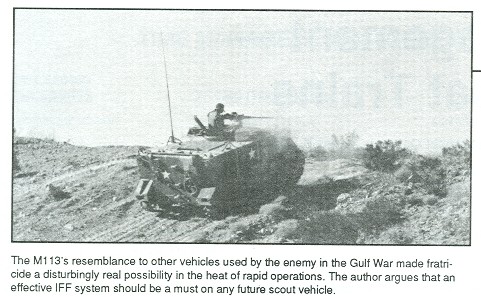
The M113's resemblance to other vehicles used by the enemy in the Gulf War made fratricide a disturbingly real possibility in the heat of rapid operations. The author argues that an effective IFF system should be a must on any future scout vehicle.
of having more than what the MTOE calls for in a scout platoon in terms of men and equipment.
The FSV designers must also deal with the biggest dilemma of the Gulf War: fratricide. Of all friendly vehicles in our task force, my scout platoon most closely resembled the enemy because of two reasons: (1) the positioning of my platoon forward and on the flanks of the unit, and (2) the enemy also had M113-like vehicles. Our unit attempted several solutions to the fratricide problem. We tried using the aircraft panel markers for day recognition and thermalized number 10 coffee cans on our antennas for night recognition. Both were only mildly effective because of the general field conditions.
Their ineffectiveness was particularly evident during one "fog of war" incident which occurred on 27 February 1991. Up until this day, my platoon had been the only force on the brigade's left and northern flank since the start of the ground war. On 27 February, however, the brigade commander moved the mechanized infantry task force to the left flank for further security. He swung them around in a wide arc (at approximately 45 degrees at a distance of 3,000 meters) to ensure that the infantry task force did not become entangled with my task force.
As the mechanized infantry task force's right flank tank company/team oriented towards our M1A1 FLOT, one of the tank gunners immediately identified and lased to a column of enemy vehicles moving in from the northeast toward my task force's M1A1 FLOT. The tank commander, who was also the platoon leader, looked through his gunner's primary sight extension and identified the vehicles as definitely moving toward the friendly FLOT but could not confirm them as friendly or enemy. After calling the spot report in and closing in to a distance of 1,000 meters toward our M1A1 FLOT, the platoon leader was able to identify the vehicles as friendly. What both he and his gunner had seen was my scout platoon in an echelon left moving off the left flank of our M1A1 FLOT. This was not apparent to either Soldier because of our movement formation, our undistinguishable vehicle form, and our lack of any easily identifiable friendly identification.
Other studies have proven that DESERT STORM made fratricide more probable because of our lack of good Identification of Friendly Force (IFF) markings and the distances at which we were engaging perceived enemy vehicles. Undoubtedly, the FSV must go forward with some system of IFF marking.
The Army wants a "ground scout vehicle that can penetrate undetected into areas under enemy control" during both "forward deployed and contingency area operations." To do so, the army needs to make that vehicle light, mobile, and survivable. Survivability will depend an its ability to sustain operations independent of immediate task force support, escape enemy detection, and distinguish itself from enemy vehicles in the form of an IFF system. Based on my DESERT STORM experiences as a task force scout platoon leader, I endorse, with some additions, the Army's current direction it is heading with the Future Scout Vehicle.
Notes
1. Armor 2000 - A Balanced Force for the Army of the Future. U.S. Army Armor Center, Fort Knox. Ky., 10 July 1990, p. 14.
2. FM 17-98, Scout Platoon. HQ, Department of the Army, Washington, D.C., October 1987, pages 2-60.
3. FM 71-2, The Tank and Mechanized Infantry Battalion Task Force, Department of the Army, Washington, D.C., September 1988, pages 3-44.
4. Ibid.
5. Armor 2000. p. 14.
-------------------
Captain John K. Tien wrote this article based on his experience as the task force scout platoon leader for 4th Battalion, 70th Armor, 2nd Brigade, 1st Armored Division, which fought in the battle of Medinah Ridge during Operation DESERT STORM.
He is a 1987 graduate of the U.S. Military Academy and received a degree in Political Science from Oxford University as a Rhodes Scholar. A graduate of the AOAC, AOBC, Airborne, and French Commando Courses, he served as a tank platoon leader, scout platoon leader, and battalion adjutant for 470th Armor in Erlangen, Germany. He is currently assigned to the 2nd Armored Division at Fort Hood.
Despite the clear lessons of DESERT SHIELD/STORM, we persisted with the Humvee truck scout non-sense that clearly doesn't work even though M113 Gavins that are great cavalry scout vehicles were and ARE available!
What about mortars?
 www.youtube.com/v/-Y-j4KCNqKM
www.youtube.com/v/-Y-j4KCNqKM
The 82nd and 101st infantry battalions have a single 81mm mortar platoon with 8 Humvee trucks and 6 mortars.
The 10th and 25th infantry battalions have a single 81mm mortar platoon with 6 Humvee trucks and 4 mortars.
If we replaced their Humvee trucks with M1064 series Gavins, we improve the armor protection, cross-country mobility and indirect 5 km firepower because they can shoot instantly from the vehicle using a turntable without having to run out and set up a mortar baseplate. We can increase range to over 7 km and HE firepower (vital in long-range desert and mountain warfare) by using the 120mm mortar in the M1064A3 variant. Our NATO allies are having outstanding success with M113 Gavin type light tanks/APCs in Afghanistan:
 www.youtube.com/v/yPkugOmfn9g
www.youtube.com/v/yPkugOmfn9g
 www.youtube.com/v/ZKa3tK3zi4c
www.youtube.com/v/ZKa3tK3zi4c
If we stretch the hull there will still be troop space inside to carry 10 men for an additional lift of 60-80. If the mortars are dismounted then 105-120 men can be transported. We may want to not initially go with a turntable mounted mortar and just use the 81mm mortar laid flay in the back and keep the full 105-120 man transportation room; essentially the M113A4 Gavin as a tracked "truck".
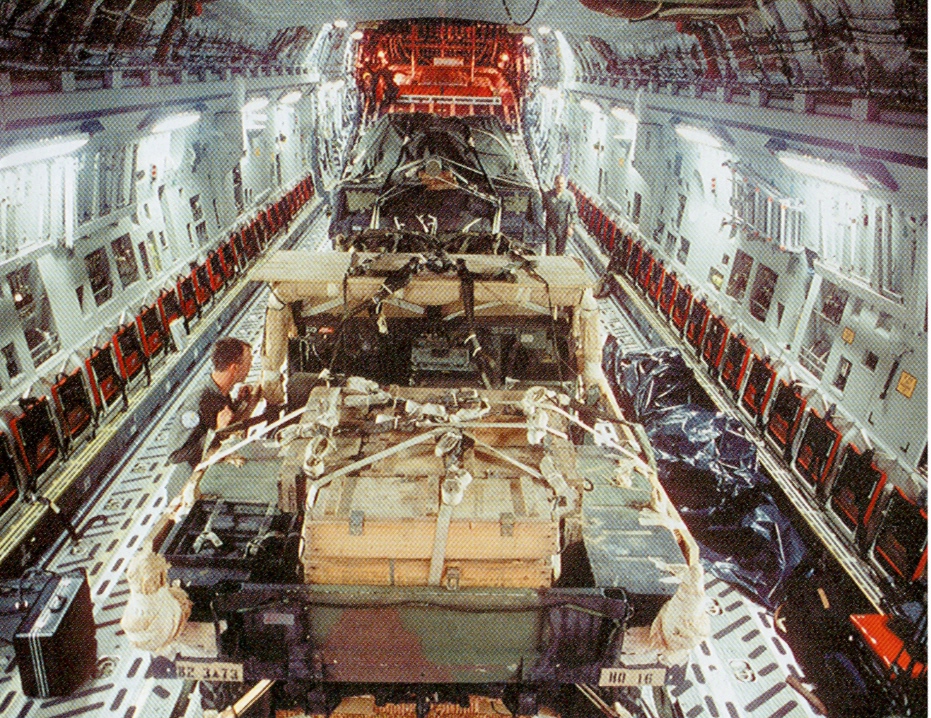
 www.youtube.com/watch?v=50cpPAVoxJQ
www.youtube.com/watch?v=50cpPAVoxJQ
The picture above of C-17 with a M551 Sheridan light tank and HMMWV truck rigged for airdrop shows 54 sidewall seats and walkways to the side jump doors are still available, yet Airborne still inefficiently loads C-17s with either all people or all equipment, then offers the excuse that they do not have the airlift to bring tracked armored vehicles to the fight below.
A mixed-load of heavy drop vehicles and personnel is easier in the wider C-17 Globemaster III transport jet. Co-author Captain X, in a 2002 airborne operation, had his men sit in the C-17's fifty-four sidewall seats with two HMMWVs rigged for airdrop in the center single-row aisle. On the first pass, the vehicles were airdropped over the rear ramp. Then on the second pass the ramp was closed and the side paratroop doors opened for his men to jump into the same DZ as their vehicles, resulting in a very quick assembly Russian Airborne-style. Thus, inside a C-17 you can single-row airdrop either two or three M113 Gavins, their respective Delta Company Soldiers, and their attached infantry squads sitting alongside their vehicles, then jump immediately on the second pass (preferably using MC1-1D steerable parachutes to land close together into a small heavy DZ adjacent to the main body's personnel DZ). While this does present the problem of a longer time period for the vehicles on the ground unsecured, it makes more efficient use of available aircraft and is an option war planners may consider.
A smaller DZ makes it easier to find vehicles in the dark; rapidly de-rigging their M113s, the Paratroopers can then launch a horizontal axis attack to unhinge the enemy also trying to cope with the main body's vertical assault. The Army's Airborne in training is already routinely launching P +:30 minutes helicopter air assaults onto DZ objectives in conjunction with the main parachute assault; such asymmetric attacks have also been done during actual combat: 1989's Operation Just Cause in Panama. Why not use Delta Anti-Armor platoons and companies in the same way?
The airborne operation planned for Haiti demonstrated that aircraft de-confliction would be made easier for planners if they had the option to use a separate heavy DZ. It is unrealistic to assume twelve to fifteen UH-60L Blackhawk helicopters are going to be nearby to launch a supporting attack or project forces at P +2 hours since the Airborne might have to project across thousands of miles of oceans; we must have an organic, ground, asymmetric attack capability. The current paratrooper is at least twenty pounds heavier in high-tech equipment than his World War Two predecessor; on foot he is actually slower. This is unacceptable! We must exceed the one- to two- mile per hour walking pace by having organic, armored, tracked mobility.
Since the Delta Company's thirty-five M113 Gavins can move the bulk of an Infantry Battalion over the ground at one to fifty miles per hour, why drop them on heavily defended airfields? Even a platoon drop of a dozen M113s moves an entire infantry company as needed. If it is important for us to take, it is important for them to defend. Much like the air assault airfield seizure Bolger describes in his book during his second stint at JRTC, exploring airfield seizure from the outside in should be considered a serious and viable option. If the main DZ is likely, and obviously, a potential beaten zone for enemy weapons fires, why drop there? Smaller DZs are possible given Global Positioning Systems (GPS) and in-flight navigation systems. A heavy drop of a dozen M113s into nearby heavy DZ, with their crews, would allow a ground-axis horizontal assault onto the main personnel DZ in conjunction with the vertical parachute drop, thus creating a two-directional assault. This means the enemy now has a true asymmetric dilemma. At whom should he shoot?
The Modern Battlefield Requires Advanced Anti-Tank Companies
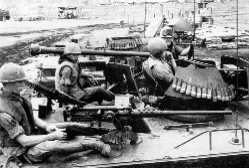
We recently stumbled upon the new anti-armor platoon and company field manual online. We as an anti-armor community have been waiting for the revisions of FM 7-91, ARTEP 7-91 Drill, and the Mission Training Plan for a long time. Our initial assessment is that it appears to be a marked improvement over the old FM 7-91. It addresses offensive and defensive operations and gives a better chapter on troop leading procedures, especially terrain analysis. Much of the field manual seems a paste of FM 71-1, which is by far, in our opinion, the most useful company level doctrine available to anyone who reads.
Unfortunately, FM 3-21.91 is deficient in several areas: it makes little discussion of the possible employment of the AT platoon and company in closed terrain and urban operations, spends little time on recurring AT missions such as convoy security, or where AT platoons are part of a company team such as route clearance. Most damning of all is a complete failure to even address the M41 ITAS. Fully fielded within the 82nd Airborne Division, 2nd Infantry Division, and partially within the 101st Airborne Division (Air Assault), and 10th Mountain Division, ITAS is a huge leap in capability able to see out to ten kilometers compared to the current five kilometer ranged thermal sights; some classify as a "3rd Generation" advance one or two steps ahead of anything even our allies have now. Unfortunately, the field manual makes no mention of ITAS capabilities, nor does it even mention the acronym ITAS in its glossary.
The impact of "cutting and pasting" another field manual's contents and "revising" the AT manual in the way it was done is that our Delta Company AT forces will remain "bastard children" of the light infantry and not fully exploited. Even the designation "anti-tank" blinds many to believe that that is its only contribution when it should be realized as also assault firepower suppliers. The anti-armor platoons and companies are misunderstood, frequently neglected, and their real combat potential is too often not actualized. The United States Army infantry does close with and destroy the enemy, but there is a great emphasis on destroying and much less on "closing" to get into positions of advantage, like denying the enemy escape routes into safe havens to fight us again another day. The "send a bullet, not a man" philosophy prevails in most of our technology and how we apply firepower and ignore maneuver. Paradoxically, when push-comes-to-shove, with bullets flying, we are going to employ our anti-tank platoons and companies in many more different ways than we do in our narrowly focused peacetime training, as Afghanistan and Iraq have proven.
In order to get the most out of our anti-tank platoons and companies, the hurdle begins with our doctrine. While doctrine should not dictate the rigid, specific employment of the anti-armor unit, it should address what the platoon is capable of, and its limitations. It is a grave deficiency that other combined-arms doctrinal publications do not adequately discuss capabilities and all of the employment options of the anti-armor platoon and company. In some cases, the units are not discussed or referenced at all! This doctrinal void in anti-armor unit discussion results in poor employment by battalions and brigades of their anti-armor platoons because many see publications as the final manifestation of all that can be done requiring no creative original employment from current leaders.
Lacking suitable discussion in the rifle company and infantry battalion field manuals, we as an infantry branch lead ourselves to ignorance and in some cases irrelevance as others more adaptive to the situation by innovative employment and equipping get the real-world missions. No one outside of an anti-armor unit will likely read FM 3-21.91, Tactical Employment of the Anti-Armor Platoon and Company, because it is not part of larger unit doctrine. It won't be discussed at leader professional development, and it won't be seen as a topic of discussion at those beautiful Fort Polk JRTC task force After-Action Reviews (AARs). What we don't understand as a branch, we will not practice, and so our training reinforces this ignorance.
Many Sensors and Shooters Are Needed To Dominate The Asymmetrical Non-Linear Battlefield
 www.youtube.com/v/jxoyVzI5lPQ
www.youtube.com/v/jxoyVzI5lPQ
Imagine U.S. forces in a heavy anti-armor fight, in need of maximum AT killing systems as they did during the march to Baghdad. Anyone with professional integrity would admit the fifty-pound Javelin ATGM, despite its amazing fire-and-forget top-attack capabilities, is "collecting dust" in arms rooms across the Army because it is too heavy to manpack. Furthermore, the Javelin is too large and too heavy to jump attached to the individual paratrooper, resulting in XVIII Airborne Corps foot-mobile units not having anti-armor and anti-bunker firepower. By equipping Delta Companies with M113 Gavins, however, we can instead have Javelins stored inside these vehicles for parachute heavy drop, and have their designated platoon gunners and assistant gunners fire their missiles from the top troop hatch (when mounted in .50 caliber and 40mm heavy machine gun equipped vehicles) dismounting for short distances through the rear ramp or troop door to employ their weapon's thermal sights in concealing terrain. Its sights have already been proven; one could also shoot Javelins from TOW-equipped M113 Gavins. The greatest restriction against longer-range Javelin shots is the limitations of its Command Launch Unit (CLU).
In a non-linear scenario against irregular, asymmetrical enemies hiding in difficult closed terrain, Army units must be able to fan out and use sensors to cover large areas to deny these foes sanctuary and escape routes. The enemy will most likely escape a thin net of mere unmanned aerial vehicles with narrow fields-of-view if the ground cordon never leaves the DZ or LZ out of fear that its rubber-tired trucks cannot survive in contested lands. This is why it is critical that AT units be mounted in light tracked Armored Fighting Vehicles (AFVs) that can "hold their own" in bad-guy land and yet still be light enough to paradrop by aircraft so to have positional advantage to flank, encircle, pursue and cut-off elusive enemies.
When we go into combat, this ignorance can branch two ways: we can maximize AT capabilities and potential from the beginning, or we can, through less-than-ideal enemy contact and accumulating casualties, decide to use the mobility and firepower of our AT units, leading us back to our historic "American Way of War." The ideal is we can realize the full mobility, firepower, and surveillance capability of our units and seek every opportunity of massing those effects using existing equipment. One needs look no further than the crucial role of our anti-armor platoons in Panama, Afghanistan and Iraq (though in the latter two situations without light tracked AFVs). More Recently, we have seen the Mk-19s and .50 caliber machine guns hammering enemy positions. We have read of how ITAS equipped units have fired dozens of TOW missiles precisely into opposition in urban areas, however to complete the mobile firepower capability, there must be adequate infantry on the scene to maneuver and hold the ground to deny its use to the enemy. Mounted infantry is hard to achieve with the current HMMWV truck in use by anti-armor companies.
Another advantage to a light tracked armored vehicle: many bad guys adhere to the "if it looks bad and tough, it is bad and tough." In the third world, many combatants use tanks, artillery and large caliber weapons as status symbols. We saw this in Afghanistan, and Afghanistan Foreign Military Studies Office (FMSO) expert Lester Grau told many deploying Army soldiers about this. The M113 Gavin looks tougher than a HMMWV, no matter how you draw the picture, and it may deter some from the opium- or culturally macho-induced pressure from taking a shot at it. It won't stop the well trained or highly motivated, but it does make someone think more about action and reaction. Clearly, a Chechen rebel was not intimidated by a tracked BMP in Grozny, and a wheeled BRDM or GaZ jeep intimidated him even less, but it is likely that many a thug would say to himself, "Hmmm, maybe I'll wait for a soft-skinned vehicle to come by. Let me go back to my warming campfire," before shooting at a Delta Company in M113 Gavins.
We hope we never have to learn the best way to employ our AT units through blood. At our CTCs, like the open-terrain National Training Center (NTC) and the closed-terrain JRTC, we learn over and over again through simulated death the crucial role of our AT units, but often we do nothing about learning from the training to correct limitations. When the next training cycle begins, our rifle platoons will be off to the shoot house and their maneuver live-fires, and the anti-armor platoons will be off to their multi-purpose ranges, never working together until the bullets are real. This parochialism must change.
We as a branch are kidding ourselves as we are awed by urban operations, and fixate upon room-clearing ignoring the most obvious fact that you first must survive and fight your way into the building before you can even begin to do room clearing. It takes a whole combined-arms team to succeed in urban operations. To limit our anti-armor platoons to blocking positions outside the urban area, or to leading the notoriously frontalist Ground Assault Convoy (GAC) is ridiculous. True, the anti-armor platoon is a stand-off supporting base of firepower effort about ninety percent of the time, especially in urban operations. But we need to educate ourselves on better employment options through actual field exercises, and we need to do it immediately. The anti-armor platoon has much to offer in terms of explosive munitions effectiveness and ITAS surveillance capabilities that will require innovative positioning.
Why do we limit the employment of our anti-armor units in training? Our heavy machine gun and Mk-19 manuals openly discuss the munitions effects of these weapons on concrete, brick and wooden logs. The M41 ITAS is generally known as the exceptional thermal sight. It offers superior thermal resolution to the AH-64A Apache, the M1A1 Abrams and M2A2 Bradley. The system can be employed mounted or dismounted, and offers a much lower noise signature than the previous TOW thermal sight. An ITAS can accurately tell if a human is carrying an M4 carbine or an AK47 at ranges under five hundred meters. The system can provide great resolution on humans beyond one kilometer. The ITAS offers vehicle identification beyond three kilometers, and detection out to ten kilometers. The ITAS can bore-sight laser aiming devices to its thermal sight to designate targets for other "killers." None of this information is hidden, and it is not hard to find more. Why not supply Delta companies with laser target designators co-axial to ITAS, and send designated Soldiers to the joint school for Emergency Close Air Support (ECAS) capabilities with USAF A-10s and pin-point 2.75-inch rockets and Hellfire ATGM support from Army AH-64 Apache gunships?
The truth is we limit much of the employment of our AT units in training because of our training locations. The southeastern United States is heavily wooded, and we have difficulty imagining how the AT unit's weapons might be employed in a close fight. When training for urban combat, our urban complexes are too small and surrounded by pine trees, so we have a tough time visualizing how our heavy weapons are going to get into the fight. As a result, AT units aren't often employed in the close fight; they guard convoys, command posts, and establish roadblocks when weapon lethality and observation capabilities are most needed to overcome enemies hiding behind urban cover. Perhaps the vulnerability of the HMMWV truck has driven these decisions, but with M113 vehicles we can boldly employ our weapons and troops where they can have maximum effect on the enemy, even if cover and concealment are lacking. The real world is not largely urban areas surrounded by pine trees.
To maximize the full potential of our AT community, we must focus our efforts on three aspects: equipment, education and training. We know that the HMMWV truck is not a combat vehicle and commanders must request war-stock M113 Gavins to replace them as our primary mobility mounts. We know that few will read the AT manual itself, and that even if they did, the AT manual is lacking crucial discussions. But we can ensure that any new infantry publication does adequately discuss anti-armor platoon employment. Discussions of the AT platoon in company and battalion manuals will plant the seeds for reference in discussions and AARs. From education will come the integration in training and full employment of the AT unit weapons and capabilities. Fixing these deficiencies will integrate our anti-armor platoons in ways we have yet to see across the Army. It will lead us to acknowledge what our AT units can offer in terms of mobility, targeting, and firepower. The crucial step for us in the targeting cycle involves detection. If you can label it as a target, your ITAS AT unit stands a good chance of detecting it. If you can detect it, the target can be destroyed.
More Reasons for an Armored Delta Weapons Company A British Army officer adds the following benefits to our proposal:
1. Protected mobility gives the CO the ability to disperse, concentrate and sustain combat power across his area of responsibility.
2. The unit can enage in limited movement by projecting one element, at a time under armour, then dismounting while the vehicles recover to pick up the next element to move.
3. Using [M113A4 Gavin] MTVL re-supply can be quickly recovered from the DZ and distributed efficently to defensive postions or harbour areas.
4. The ability to use [M113A4 Gavin] MTVL for re-supply means postions that would be un-sustainable on foot can be achieved.
5. [M113A4 Gavin] MTVL allows for the the protection and sustainment of forward ISTAR assetts, and reduces the number and proximity of Soldiers allocated to QRF.
We Can Do This: Airborne, Armored All-Weather Ground Power Projection
An expensive but strategic trump card like the 82nd Airborne Division needs to have organic armored ground mobility starting with the alpha-echelon, not a gradual build-up beginning with the air-landed bravo echelon many hours too late, after the enemy has escaped. What if the enemy mortars your runway starting at P+2 hours and shuts it down for twenty-six hours?
What now colonel?
"That could never happen," he replies.
Response: Witness the marine Khe Sanh Combat Base in Vietnam. It can happen, it has already happened, and it is time for us to make sure it does not happen again. Fifty percent of an Army heavy division is equipped with M113s. The PLL and the trailed mechanics are all in place to support a relatively small number of these vehicles in the 82nd Airborne Division. We would have guaranteed fifteen kilometers (or more) of power projection from the drop zones by P+2 hours with absolute mobile reserve and follow-on mission capability, despite bad weather or aircraft unavailability. We could have the world's best armored, cross-country mobile, long-range sensor and shooter mechanized infantry assault unit in the world in a few short weeks; all we have to do is ask for the vehicles from war stocks.
NOTES
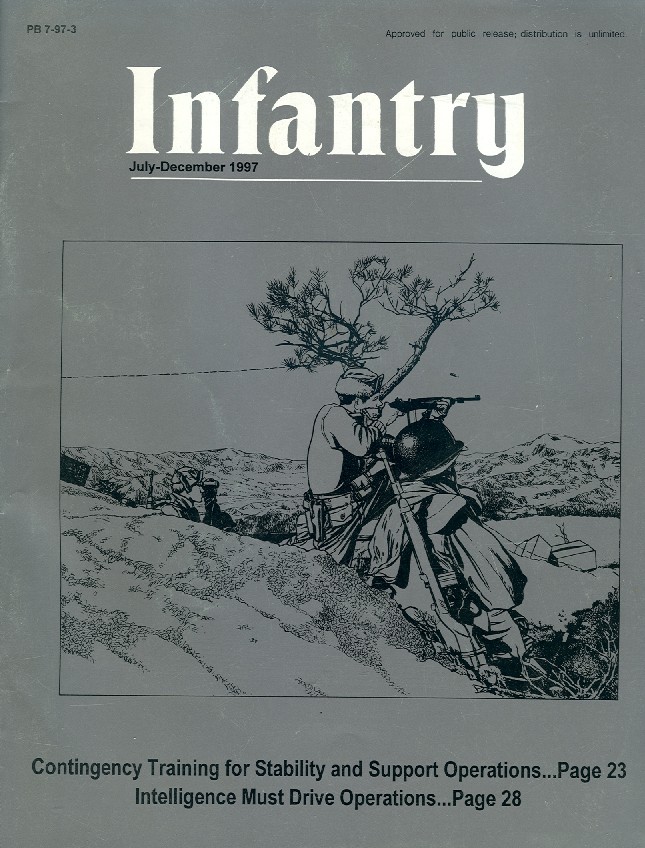
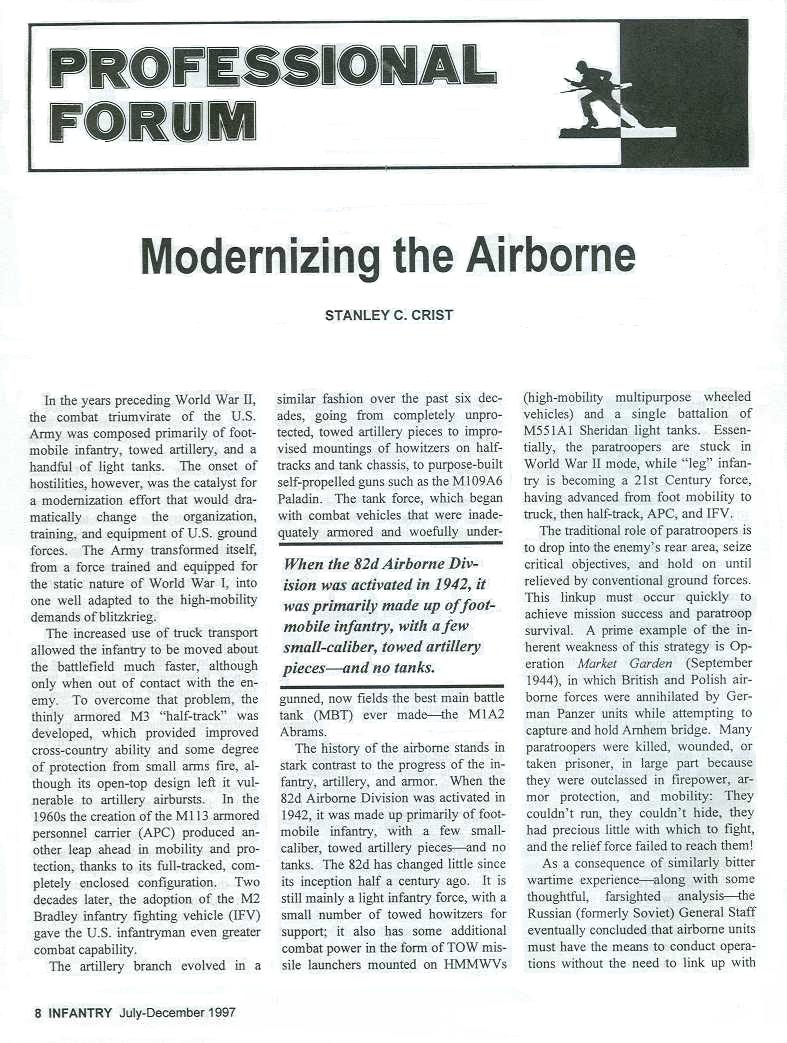
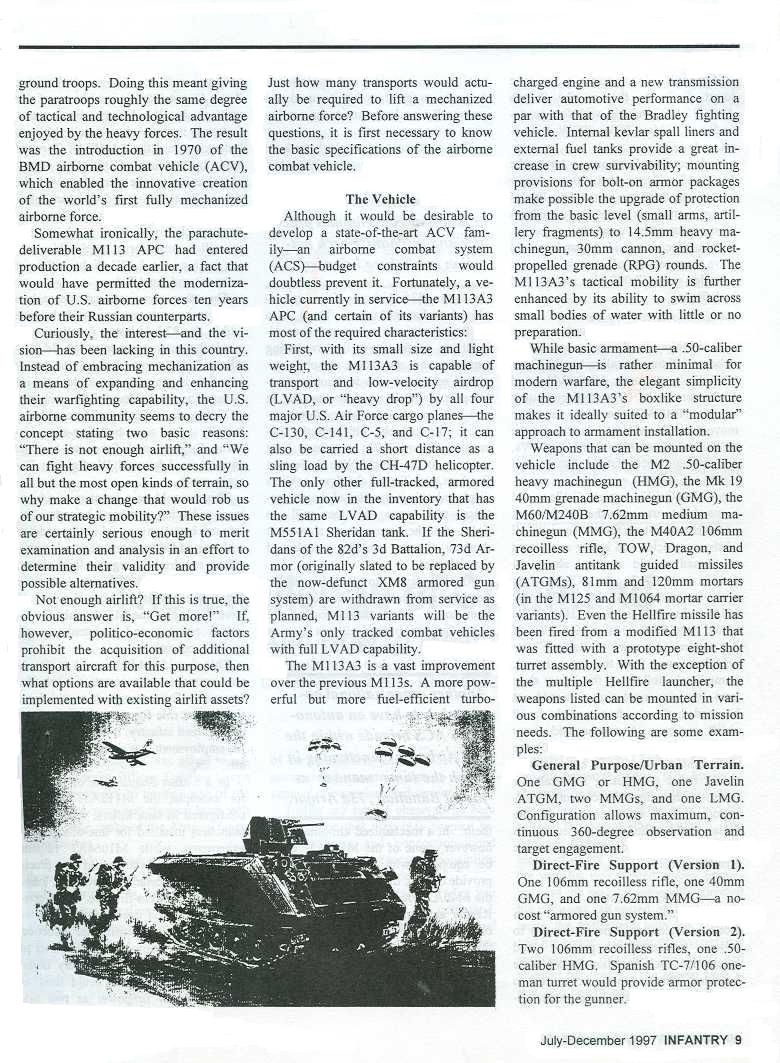
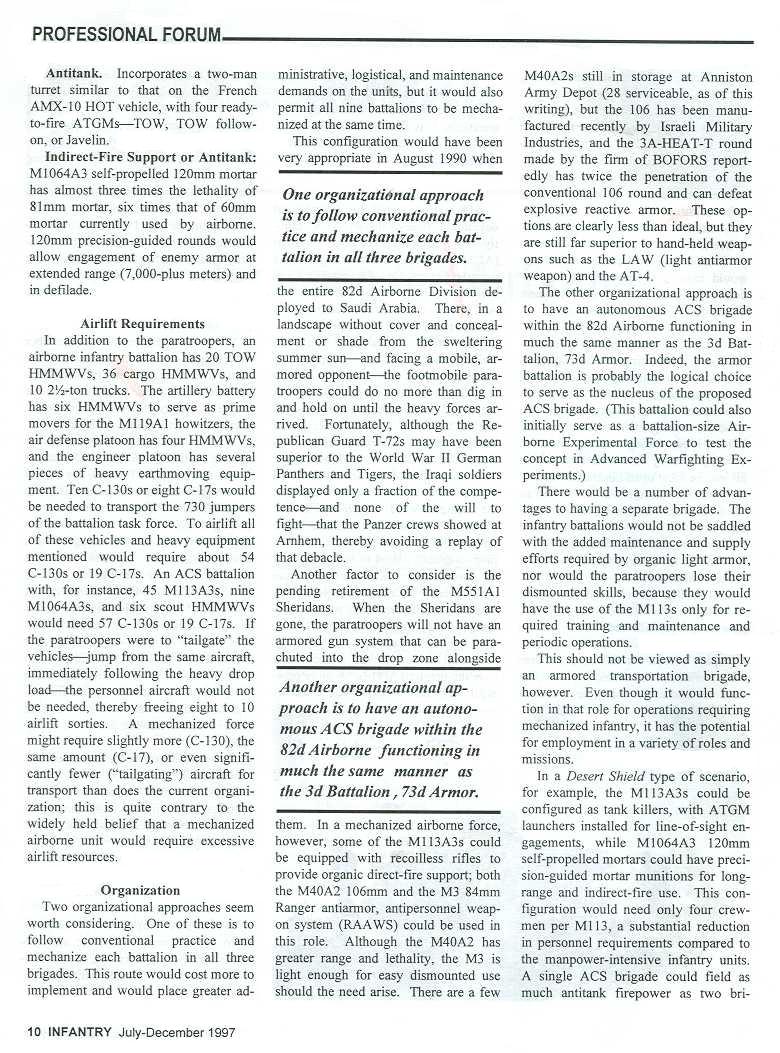
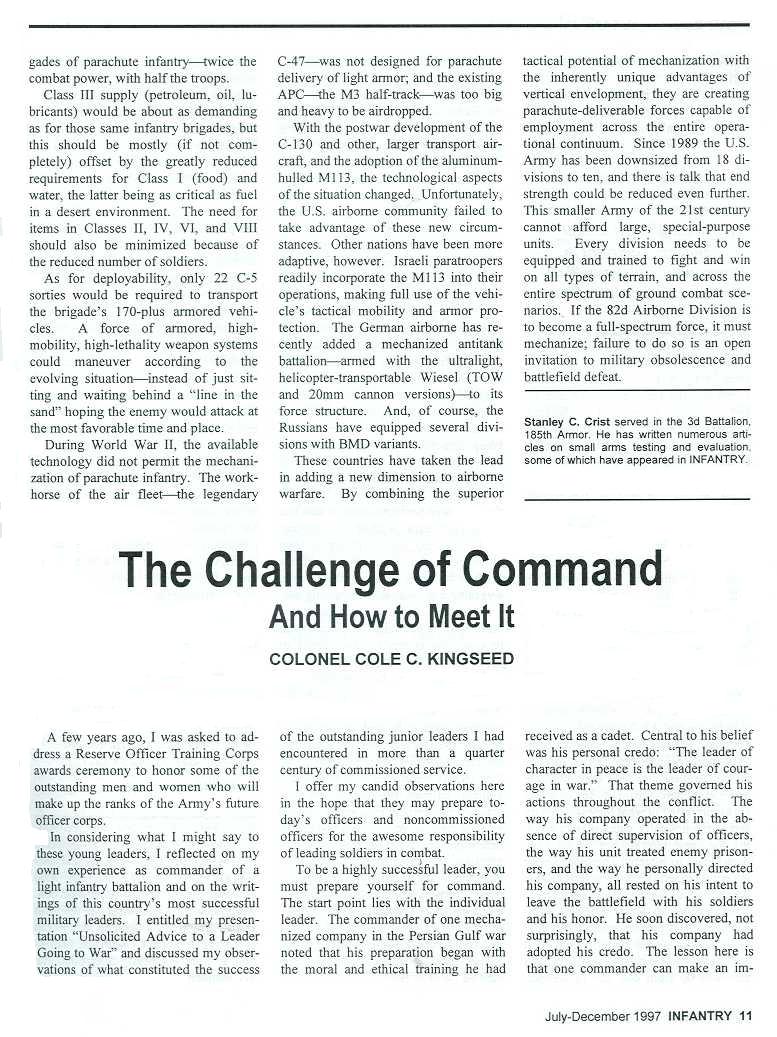
www.combatreform.org/modernizetheairborne.htm
Modernizing the Airborne
PROFESSIONAL NOTES
By Stan Crist
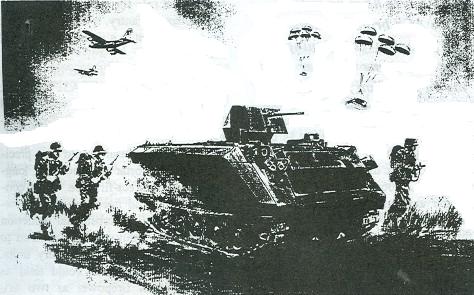
In the years preceding, World War II, the combat triumvirate of the U.S. Army was composed primarily of foot-mobile infantry, towed artillery, and a handful of light tanks. The onset of hostilities, however, was the catalyst for a modernization effort that would dramatically change the organization, training, and equipment of U.S. ground forces. The Army transformed itself, from a force trained and equipped for the static nature of World War I, into one well adapted to the high-mobility demands of blitzkrieg.
The increased use of truck transport allowed the infantry to be moved about the battlefield much faster, although only when out of contact with the enemy. To overcome that problem, the thinly armored M3 "half-track" was developed, which provided improved cross-country ability and some degree of protection from small arms fire, although its open-top design left it vulnerable to artillery airbursts. In the 1960s the creation of the M113 [Gavin] armored personnel carrier (APC) produced another leap ahead in mobility and protection, thanks to its full-tracked, completely enclosed configuration. Two decades later, the adoption of the M2 Bradley infantry fighting vehicle (IFV) gave the U.S. infantryman even greater combat capability.
The artillery branch evolved in a
Page 8 INFANTRY July-December 1997
STANLEY C. CRIST
similar fashion over the past six decades, going from completely unprotected, towed artillery pieces to improvised mountings of howitzers on half-tracks and tank chassis, to purpose-built self-propelled guns such as the MI09A6 Paladin. The tank force, which began with combat vehicles that were inadequately armored and woefully under-
When the 82nd Airborne Division was activated in 1942, it was primarily made up of foot-mobile infantry, with a few small-caliber, towed artillery pieces--and no tanks.
gunned, now fields the best main battle [heavy] tank (MBT) ever made-the M1A2 Abrams. The history of the airborne stands in stark contrast to the progress of the infantry, artillery, and armor. When the 82nd Airborne Division was activated in 1942, it was made up primarily of foot-mobile infantry, with a few small caliber, towed artillery pieces-and no tanks. The 82nd has changed little since its inception half a century ago. It is still mainly a light infantry force, with a small number of towed howitzers for support; it also has some additional combat power in the form of TOW missile launchers mounted on HMMWVs (high-mobility multipurpose wheeled vehicles) and a single battalion of M551A1 Sheridan light tanks. Essentially, the paratroopers are stuck in World War II mode, while "leg" infantry is becoming a 21st Century force, having advanced from foot mobility to truck, then half-track, APC, and IFV. The traditional role of paratroopers is to drop into the enemy's rear area, seize critical objectives, and hold on until relieved by conventional ground forces.
This linkup must occur quickly to achieve mission success and paratroop survival. A prime example of the inherent weakness of this strategy is Operation Market Garden (September 1944), in which British and Polish airborne forces were annihilated by German Panzer units while attempting to capture and hold Arnhem bridge. Many paratroopers were killed, wounded, or taken prisoner, in large part because they were outclassed in firepower, armor protection, and mobility: They couldn't run, they couldn't hide, they had precious little with which to fight, and the relief force failed to reach them!
 www.youtube.com/watch?v=VSm5nBZ4X0A
www.youtube.com/watch?v=VSm5nBZ4X0A
As a consequence of similarly bitter wartime experience---along with some thoughtful, farsighted analysis-the Russian (formerly Soviet) General Staff eventually concluded that airborne units must have the means to conduct operations without the need to link up with ground troops. Doing this meant giving the paratroops roughly the same degree of tactical and technological advantage enjoyed by the heavy forces. The result was the introduction in 1970 of the BMD airborne combat vehicle (ACV), which enabled the innovative creation of the world's first fully mechanized airborne force.
 www.youtube.com/watch?v=_hrvgYEI90c
www.youtube.com/watch?v=_hrvgYEI90c
Somewhat ironically, the parachute deliverable M113 APC had entered production a decade earlier, a fact that would have permitted the modernization of U.S. airborne forces ten years before their Russian counterparts.
 www.youtube.com/watch?v=zD4RWmotso0
www.youtube.com/watch?v=zD4RWmotso0
Curiously, the interest--and the vision-has been lacking in this country. Instead of embracing mechanization as a means of expanding and enhancing their warfighting capability, the U.S. airborne community seems to decry the concept stating two basic reasons: "There is not enough airlift," and "We can fight heavy forces, successfully in all but the most open kinds of terrain, so why make a change that would rob us of our strategic mobility?" These issues are certainly serious enough to merit examination and analysis in an effort to determine their validity and provide possible alternatives.
Not enough airlift? If this is true, the obvious answer is, "Get more!" If, however, politico-economic factors prohibit the acquisition of additional transport aircraft for this purpose, then what options are available that could be implemented with existing airlift assets?
Just how many transports would actually be required to lift a mechanized airborne force? Before answering these questions, it is first necessary to know the basic specifications of the airborne combat vehicle.
The Vehicle
Although it would be desirable to develop a state-of-the-art ACV family-an airborne combat system (ACS}---budget constraints would doubtless prevent it. Fortunately, a vehicle currently in service--the M113A3 APC (and certain of its variants) has most of the required characteristics: First, with its small size and light weight, the M113A3 is capable of transport and low-velocity airdrop (LVAD, or "heavy drop") by all four major U.S. Air Force cargo planes-the C-130, C-141, C-5, and C-17; it can also be carried a short distance as a sling load by the CH-47D helicopter. The only other full-tracked, armored vehicle now in the inventory that has the same LVAD capability is the M551A1 Sheridan tank. If the Sheridans of the 82nd's 3rd Battalion, 73rd Armor (originally slated to be replaced by the now-defunct XM8 [Buford] armored gun system) are withdrawn from service as planned, M113 variants will be the Army's only tracked combat vehicles with full LVAD capability.
 www.youtube.com/watch?v=htdQVbmvLgQ
www.youtube.com/watch?v=htdQVbmvLgQ
The M113A3 is a vast improvement over the previous M113s. A more powerful but more fuel-efficient turbocharged engine and a new transmission deliver automotive performance on a par with that of the Bradley fighting vehicle. Internal kevlar spall liners and external fuel tanks provide a great increase in crew survivability; mounting provisions for bolt-on armor packages make possible the upgrade of protection trom the basic level (small arms, artillery fragments) to 14.5mm heavy machinegun, 30mm cannon, and rocket-propelled grenade (RPG) rounds. The MI13A3's tactical mobility is further enhanced by its ability to swim across small bodies of water with little or no preparation.
 www.youtube.com/watch?v=9VMgdFUd1JU
www.youtube.com/watch?v=9VMgdFUd1JU
While basic armament-a .50-caliber [heavy] machinegun-is rather minimal for modem warfare, the elegant simplicity of the M113A3's box-like structure makes it ideally suited to a "modular" approach to armament installation.
 www.youtube.com/watch?v=9SPHgpLWPws
www.youtube.com/watch?v=9SPHgpLWPws
Weapons that can be mounted on the vehicle include the M2 .50-caliber heavy machinegun (HMG), the Mk 19 40mm grenade machinegun (GMG), the M60/M240B 7.62mm medium machinegun (MMG), the M40A2 106mm recoilless rifle, TOW, Dragon, and Javelin antitank guided missiles (ATGMs), 81mm and 120mm mortars (in the M125 and M1064 mortar carrier variants). Even the Hellfire missile has been fired from a modified M113 that was fitted with a prototype eight-shot turret assembly. With the exception of the multiple Hellfire launcher, the weapons listed can be mounted in various combinations according to mission needs. The following are some examples:
General Purpose, Urban Terrain.
One GMG or HMG, one Javelin ATGM, two MMGs, and one LMG.
Configuration allows maximum, continuous 360-degree observation and target engagement.
Direct-Fire Support (Version 1).
One 106mm recoilless rifle, one 40mm GMG, and one 7.62mm MMG-a no cost "armored gun system." Direct-Fire Support (Version 2).
Two 106mm recoilless rifles, one .50 caliber HMG. Spanish TC-7/106 one-man turret would provide armor protection for the gunner.
Page 9 July-December 1997 INFANTRY
Antitank.
Incorporates a two-man turret similar to that on the French AMX-10 HOT vehicle, with four ready-to-fire ATGMs-TOW, TOW follow-on, or Javelin.
Indirect-Fire Support or Antitank.
M1064A3 self-propelled 120mm mortar has almost three times the lethality of 81mm mortar, six times that of 60mm mortar currently used by airborne. 120mm precision-guided rounds would allow engagement of enemy armor at extended range (7,000-plus meters) and in defilade.
 www.youtube.com/watch?v=-Y-j4KCNqKM
www.youtube.com/watch?v=-Y-j4KCNqKM
Airlift Requirements
In addition to the Paratroopers, an airborne infantry battalion has 20 x TOW HMMWVs, 36 x cargo HMMWVs, and 10 x 2.5-ton trucks [ED: these weigh 10.5 tons--exactly the same as M113s]. The artillery battery has six HMMWVs to serve as prime movers for the M1l9A1 [105mm] howitzers, the air defense platoon has four HMMWVs, and the engineer platoon has several pieces of heavy earthmoving equipment. Ten C-130s or eight C-17s would be needed to transport the 730 jumpers of the battalion task force. To airlift all of these vehicles and heavy equipment mentioned would require about 54 x C-130s or 19 x C-17s. An ACS battalion with, for instance, 45 x M1l3A3s, nine x M1064A3s, and six scout HMMWVs would need 57 x C-130s or 19 x C-17s. If the paratroopers were to "tailgate" the vehicles-jump from the same aircraft, immediately following the heavy drop load--the personnel aircraft would not be needed, thereby freeing eight to 10 airlift sorties. A mechanized force might require slightly more (C-130), the same amount (C-17), or even significantly fewer ("tailgating") aircraft for transport than does the current organization; this is quite contrary to the widely held belief that a mechanized airborne unit would require excessive airlift resources.
 www.youtube.com/watch?v=50cpPAVoxJQ
www.youtube.com/watch?v=50cpPAVoxJQ
Organization
Two organizational approaches seem worth considering. One of these is to follow conventional practice and mechanize each battalion in all three brigades. This route would cost more to implement and would place greater administrative, logistical, and maintenance demands on the units, but it would also permit all nine battalions to be mechanized at the same time.
This configuration would have been very appropriate in August 1990 when
One organizational approach is to follow conventional practice and mechanize each battalion in all three brigades.
the entire 82nd Airborne Division deployed to Saudi Arabia. There in a landscape without cover and concealment or shade from the sweltering summer sun-and facing a mobile, armored opponent-the foot-mobile paratroopers could do no more than dig in and hold on until the heavy forces arrived. Fortunately, although the Republican Guard T-72s may have been superior to the World War II German Panthers and Tigers, the Iraqi soldiers displayed only a fraction of the competence--and none of the will to fight-that the Panzer crews showed at Arnhem, thereby avoiding a replay of that debacle.
Another factor to consider is the pending retirement of the M551A1 Sheridans. When the Sheridans are gone, the paratroopers will not have an armored gun system that can be parachuted into the drop zone alongside them. In a mechanized airborne force, however, some of the M113A3s could be equipped with recoilless rifles to provide organic direct-fire support; both the M40A2 106mm and the M3 84mm Ranger antiarmor, antipersonnel weapon system (RAAWS) could be used in this role. Although the M40A2 has greater range and lethality, the M3 is light enough for easy dismounted use should the need arise. There are a few M40A2s still in storage at Anniston Army Depot (28 serviceable, as of this writing), but the 106 has been manufactured recently by Israeli Military Industries, and the 3A-HEAT-T round made by the firm of BOFORS reportedly has twice the penetration of the conventional 106 round and can defeat explosive reactive armor. These options are clearly less than ideal, but they are still far superior to hand-held weapons such as the LAW (light anti-armor weapon) and the AT-4.
The other organizational approach is to have an autonomous ACS brigade within the 82nd Airborne functioning in much the same manner as the 3rd Battalion, 73rd Armor. Indeed, the armor battalion is probably the logical choice to serve as the nucleus of the proposed ACS brigade. (This battalion could also initially serve as a battalion-size Airborne Experimental Force to test the concept in Advanced Warfighting Experiments.)
There would be a number of advantages to having a separate brigade. The infantry battalions would not be saddled with the added maintenance and supply efforts required by organic light armor, nor would the paratroopers lose their dismounted skills, because they would have the use of the M113s only for required training and maintenance and periodic operations.
This should not be viewed as simply an armored transportation brigade, however. Even though it would function in that role for operations requiring mechanized infantry, it has the potential for employment in a variety of roles and missions.
In a Desert Shield type of scenario, for example, the M113A3s could be configured as tank killers, with ATGM launchers installed for line-of-sight engagements, while M1064A3 120mm self-propelled mortars could have precision-guided mortar munitions for long-range and indirect-fire use. This configuration would need only four crewmen per M113; a substantial reduction in personnel requirements compared to the manpower-intensive infantry units.
A single ACS brigade could field as much antitank firepower as two bri-
Page 10 INFANTRY July-December 1997
gades of parachute infantry--twice the combat power, with half the troops. Class III supply (petroleum, oil, lubricants) would be about as demanding as for those same infantry brigades, but this should be mostly (if not completely) offset by the greatly reduced requirements for Class I (food) and water, the latter being as critical as fuel in a desert environment. The need for items in Classes II, IV, VI, and VIII should also be minimized because of the reduced number of Soldiers.
As for deployability, only 22 C-5 sorties would be required to transport the brigade's 170-plus armored vehicles. A force of armored, high mobility, high-lethality weapon systems could maneuver according to the evolving situation-instead of just sitting and waiting behind a "line in the sand" hoping the enemy would attack at the most favorable time and place.
During World War II, the available technology did not permit the mechanization of parachute infantry. The workhorse of the air fleet--the legendary C-47-was not designed for parachute delivery of light armor; and the existing APC-the M3 half-track-was too big and heavy to be airdropped.
With the post-war development of the C-130 and other, larger transport aircraft, and the adoption of the aluminum-hulled M113, the technological aspects of the situation changed. Unfortunately, the U.S. airborne community failed to take advantage of these new circumstances. Other nations have been more adaptive, however. Israeli paratroopers readily incorporate the M113 into their operations, making full use of the vehicle's tactical mobility and armor protection. The German airborne has recently added a mechanized antitank battalion-armed with the ultralight, helicopter-transportable Wiesel (TOW and 20mm cannon versions}-to its force structure. And, of course, the Russians have equipped several divisions with BMD variants.
These countries have taken the lead in adding a new dimension to airborne warfare. By combining the superior tactical potential of mechanization with the inherently unique advantages of vertical envelopment, they are creating parachute-deliverable forces capable of employment across the entire operational continuum. Since 1989 the U.S. Army has been downsized from 18 divisions to ten, and there is talk that end strength could be reduced even further. This smaller Army of the 21st century cannot afford large, special-purpose units. Every division needs to be equipped and trained to fight and win on all types of terrain, and across the entire spectrum of ground combat scenarios. If the 82nd Airborne Division is to become a full-spectrum force, it must mechanize; failure to do so is an open invitation to military obsolescence and battlefield defeat.
Stanley C. Crist served in the 3rd Battalion, 185th Armor. He has written numerous articles on small arms testing and evaluation, some of which have appeared in INFANTRY.
combatreform.org/lightinfantryneedslighttanks.htm
We Told You So: Why Are Medium Bradleys and Heavyweight Abrams Tanks Sitting in Motor Pools in the USA while American Light Infantry is Getting Creamed in Wheeled Trucks and On Foot in Afghanistan when LIGHT M113 Gavins are Available?
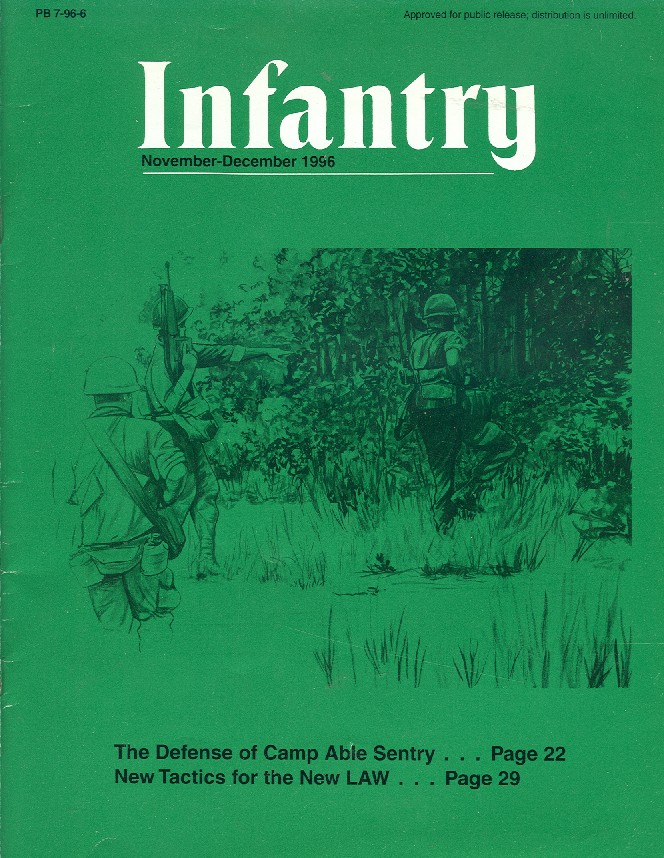
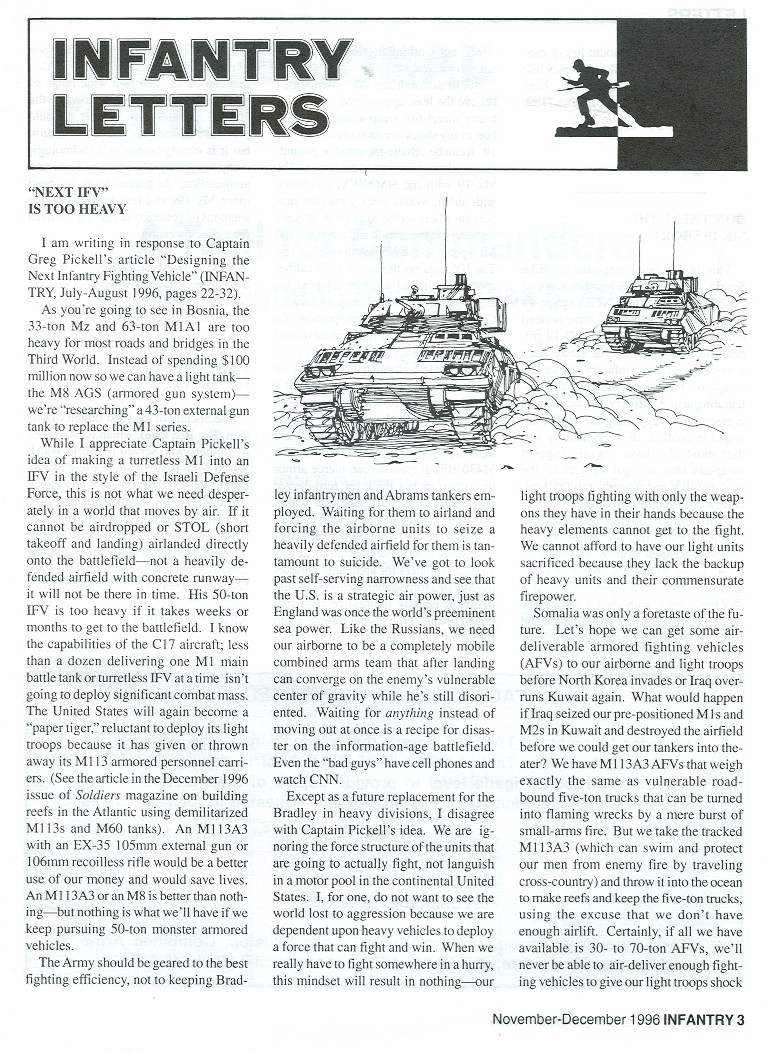
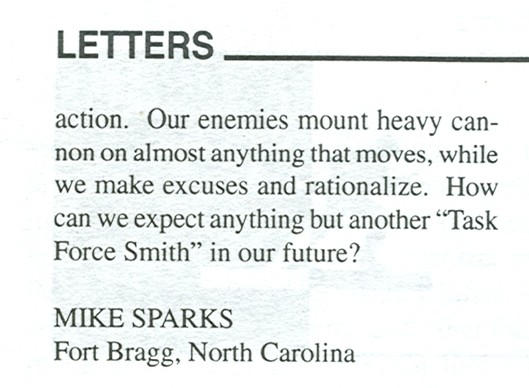
INFANTRY LETTERS
"NEXT IFV" IS TOO HEAVY
I am writing in response to Captain Greg Pickell's article "Designing the Next Infantry Fighting Vehicle" (INFANTRY, July-August 1996, pages 22-32).
As you're going to see in Bosnia, the 33-ton M2 and 63-ton M1A1 are too heavy for most roads and bridges in the Third World. Instead of spending $100 million now so we can have a light tank the M8 AGS (armored gun system) we're "researching" a 43-ton external gun tank to replace the M1 series.
While I appreciate Captain Pickell's idea of making a turretless M1 into an IFV in the style of the Israeli Defense Force, this is not what we need desperately in a world that moves by air. If it cannot be airdropped or STOL (short takeoff and landing) airlanded directly onto the battlefield-not a heavily defended airfield with concrete runway it will not be there in time. His 50-ton IFV is too heavy if it takes weeks or months to get to the battlefield. I know the capabilities of the C-17 aircraft; less than a dozen delivering one M1 main battle tank or turretless IFV at-a-time isn't going to deploy significant combat mass.
The United States will again become a "paper tiger," reluctant to deploy its light troops because it has given or thrown away its M113 armored personnel carriers. (See the article in the December 1996 issue of Soldiers magazine on building reefs in the Atlantic using demilitarized M113s and M60 tanks). An M113A3 with an EX-35 105mm external gun or 106mm recoilless rifle would be a better use of our money and would save lives.
An M113A3 or an M8 is better than nothing-but nothing is what we'll have if we keep pursuing 50-ton monster armored vehicles. The Army should be geared to the best fighting efficiency, not to keeping Bradley infantrymen and Abrams tankers employed. Waiting for them to airland and forcing the airborne units to seize a heavily defended airfield for them is tantamount to suicide. We've got to look past self-serving narrowness and see that the U.S. is a strategic air power, just as England was once the world's preeminent sea power. Like the Russians, we need our airborne to be a completely mobile combined arms team that after landing can converge on the enemy's vulnerable center of gravity while he's still disoriented. Waiting for anything instead of moving out at once is a recipe for disaster on the information-age battlefield. Even the "bad guys" have cell phones and watch CNN.
Except as a future replacement for the Bradley in heavy divisions, I disagree with Captain Pickell's idea. We are ignoring the force structure of the units that are going to actually fight, not languish in a motor pool in the continental United States. I, for one, do not want to see the world lost to aggression because we are dependent upon heavy vehicles to deploy a force that can fight and win. When we really have to fight somewhere in a hurry, this mindset will result in nothing-our light troops fighting with only the weapons they have in their hands because the heavy elements cannot get to the fight. We cannot afford to have our light units sacrificed because they lack the backup of heavy units and their commensurate firepower.
Somalia was only a foretaste of the future. Let's hope we can get some air-deliverable armored fighting vehicles (AFVs) to our airborne and light troops before North Korea invades or Iraq overruns Kuwait again. What would happen if Iraq seized our pre-positioned M1s and M2s in Kuwait and destroyed the airfield before we could get our tankers into theater? We have M113A3 AFVs that weigh exactly the same as vulnerable road bound five-ton trucks that can be turned into flaming wrecks by a mere burst of small-arms fire. But we take the tracked M113A3 (which can swim and protect our men from enemy fire by traveling cross-country) and throw it into the ocean to make reefs and keep the five-ton trucks, using the excuse that "we don't have enough airlift". Certainly, if all we have available is 30 to 70-ton AFVs, we'll never be able to air-deliver enough fighting vehicles to give our light troops shock
November-December 1996 INFANTRY 3
action. Our enemies mount heavy cannon on almost anything that moves, while we make excuses and rationalize. How can we expect anything but another "Task Force Smith" in our future?
MIKE SPARKS
Fort Bragg, North Carolina
November-December 1996 INFANTRY 4
What if You Don't Like "Dragoons"...How About "MECHANDOs?"
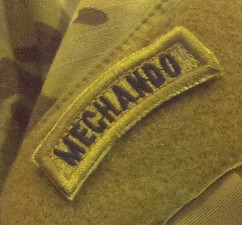
 http://youtu.be/CZ6sMy4y7xQ
http://youtu.be/CZ6sMy4y7xQ
Authors' Biographies
Brigadier General (Retired) David Grange is the Chief Executive Officer of the McCormick Tribune Foundation in Chicago, Illinois, a 30-year Army veteran of the Vietnam War, Operation Urgent Fury in Grenada, Operations Desert Shield and Desert Storm in Saudi Arabia and Iraq, and Bosnia. He is a graduate of North Georgia Military College.
Captain X is the former Commanding Officer of a Delta Company in the 82nd Airborne and led his men in combat in Operation Enduring Freedom in Afghanistan. He is a graduate of Norwich University.
First Lieutenant Mike Sparks was a Platoon Leader in an U.S. Army Reserve Airborne unit. He is a former enlisted Non-Commissioned Officer/Officer in the USMC/R and is a graduate of Liberty University.
Staff Sergeant Brian Heitman was an Anti-Tank Section Leader in Delta Company, 2nd Battalion, 504th Parachute Infantry Regiment. He is a combat veteran of Operations Desert Shield, Desert Storm, Operation Iraqi Freedom in Saudi Arabia and Iraq, and Operation Enduring Freedom in Afghanistan.
The authors have come together to write two editions of the book, "Air-Mech-Strike: Asymmetric Maneuver Warfare for the 21st Century".
FEEDBACK!
A veteran "Red Leg" Artillery Paratrooper writes:
"Dear Mike,
'I advocate M1064A3s 120mm mortars with an ulterior motive---to ground mount the 120mm mortars and free the carriers to transport infantry. The 120mm mortars can fire guided anti-armor projectiles and do indirect, high angle fire, good for MOUT/trenches etc."
Ah...I see...hehe. Well being of the fire support mind, more steel on target is a good thing.
Like I said....I am totally ignorant to the role of APCs and other 'Mech' type vehicles. I spent all my time in the 82nd so I didn't get to see much.
But, that being said...I did witness guys trying to rig-up 5 tons and 2.5's for air deployment. I always thought they were a little big for that. I know you are right about HQDA, and light divisions. We did a number of field exercises where we never even saw our HMMWVs. A towed artillery unit going 2 weeks with out a truck? We had to coordinate with the UH-60 troops for transpo. I mean it was cool if we did a 3 or 6 gun raid...but we needed them just to move from one firing position to another. And that pretty much would mean we would be dead in a RW engagement...no trucks to evac under fire(a task we had to perform for section evals anyway). We would have to sit under counter fire without being able to leave. So I see if they did assign the M113 or a like vehicle to the 82nd, it would spend more time in the motor pool than in the field. The doctrine would go something like this: "Once you have secured the DZ, your APCs will be brought in with follow on forces when they arrive, but in the mean time move out to your secondary objectives and we will call you when they get here"
If there is a vehicle in the current TO&E that would give Airborne and air-moble light infranty another combat capability, that meets there deployment requirements, it should be assigned. If that vehicle can be air-dropped, air-lifted, or slung under a shit-hook, then it should be used.
Maybe in company sized elements at first. If I remember right, the infantry battalions in the 82nd are cut up into 3 light inf. maneuver companies, and 1 anti-tank (turtle hummer with TOW) company. Make the new battalion line of march to be 2 light inf. maneuver companies, 1 armored/mech company, and 1 anti-tank company (mix platoons of armored and HMMWV). I am not an expert but that would give the battalion task force something to breech strong defensive positions. And with the addition of a platoon or company sized element of light armor, every thing could be done in house, which gives the division more punch in that 72 hour period (which is longer cause it will take more than that to alert and move any division sized heavy elements to the theatre). Once the vehicle has proven its usefulness, then the Divsion command staff can make the final decision on wether or not to implement it through out the battalion task force or not.
Which brings me to another beef. The largest manuever element in the current doctrine is the Division right? If that is so, how can someone on "the hill" make a decision on what the division or brigade needs to accomplish its mission. That is like telling you what kind of things you need in YOUR car.
Oh..I know that DA hates the Airborne. The Officer Corps wants to have the wings...but doesn't want the work. My graduating jump school class was almost 600 strong. Of that 600 less than 100 ended up doing time as a Airborne assignment. The other 500 went back to leg business as usual. And the officers just went back to the career track. I don't think everyone needs to be Airborne. I think between the 1 division, and 2 separate task forces we have, that the mission is there. The mission is the issue. Not the Airborne. All units have a mission statement. That takes us back to the inferiority issue. There isn't a damn thing we can do to change their minds.
They keep the Airborne/Special community locked up in the kennel and only pull them out when the more conventional elements are either incapable or unwilling to perform the mission. They pat them on the head and say 'good job' but get back in the cage.
Yet, look at the last 3 Chairmen of the Joint Chiefs. 2 were from the Airborne community, the other was a ticket puncher. So, obviously the Airborne community is either what you want for leadership, or something to get a ticket punched on your way up. For someone to hate that community is simply ridiculous. Their very actions tell us that they can't live without them....maybe that is why they don't like them."
Private Murphy's View

RETURN TO AIRBORNE WARFARE CONTENTS PAGE